We almost didn’t come to Fiji. Tonga was becoming more and more comfortable to us. Neither of us were really looking forward to another passage, and we had decided to sell Cool Change. There really was no point, other than that perhaps Fiji would be an easier place to sell a boat.
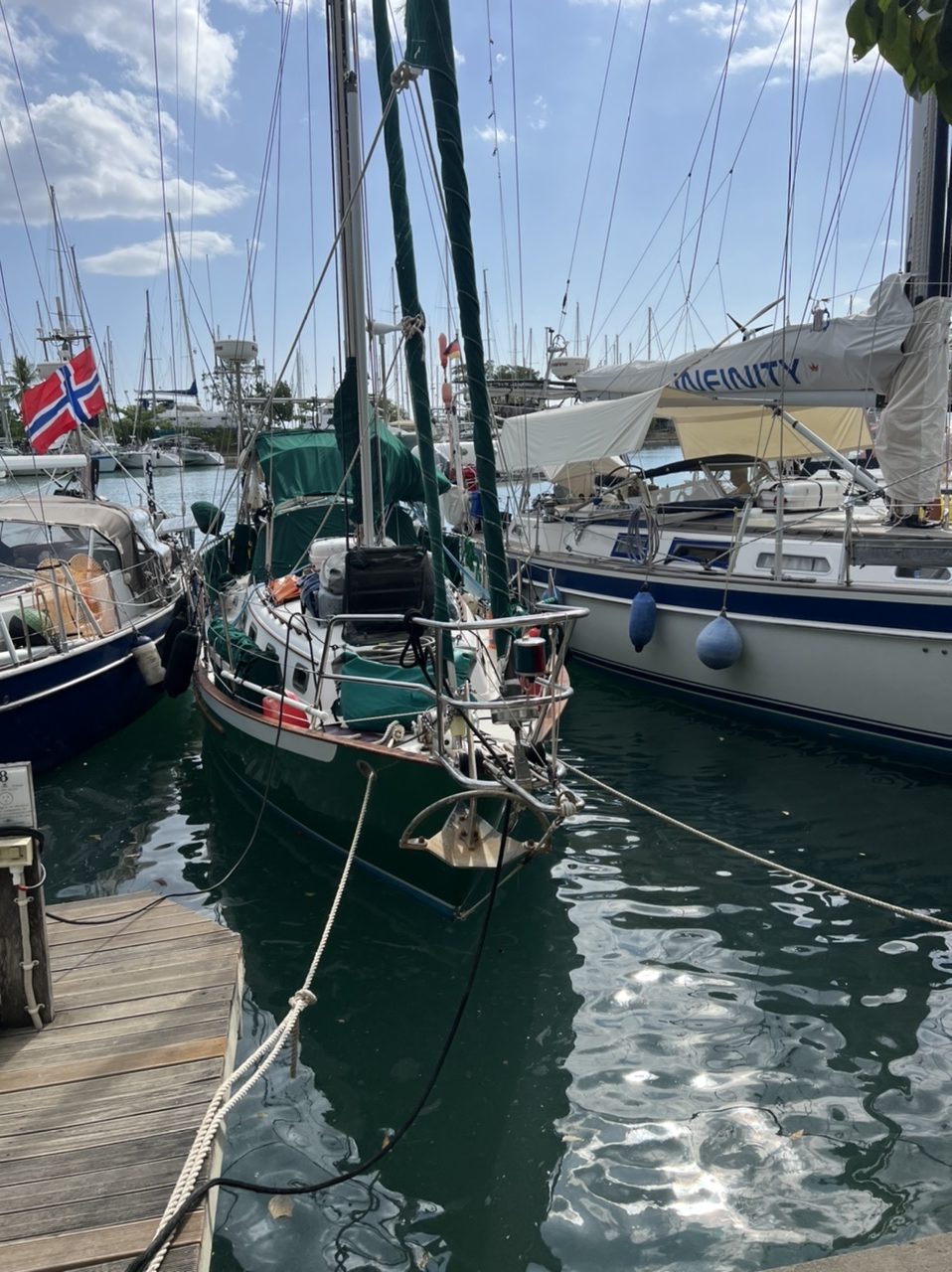
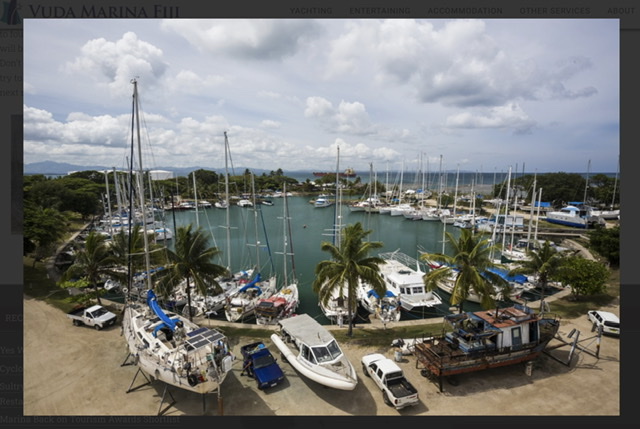
But here we are and we almost can’t believe how nice it is! So far we have only been to five islands. There are 295 islands left to explore! Best I can tell, the area of Fiji we are currently visiting supports a tremendously large tourist population, principally from Australia, to a lesser extent, New Zealand, and then a smattering of tourists from other countries. Accommodations vary from luxurious, romantic, adult-only resorts with individual ocean view dwellings for each couple, to dormitory-style beds for an international crowd of young surfers, all scattered along miles and miles of white sand beaches on small islands off the west coast of the largest of Fiji’s islands. Although all the resorts seem to be full, they are almost all self-contained with small, single story cabins nestled inside the palm trees, so it is really hard to tell there are many people here.
These west coast islands are entirely enclosed inside a reef that stops the ocean swell in its tracks, so that waves never build very high on any route between islands. More often than not, especially at this time of year, the main island serves to create a wind shadow from the easterly trade winds for the west coast islands, so the wind rarely blows in the west as hard as it does north or south of Fiji. There are far more remote and interesting islands to visit on the east side of both of the principal islands that make up the island nation of Fiji, where snorkeling opportunities abound, the indigenous people walk on fire, and you must obtain permission from the island chief to anchor. There is a little bit of that on this side, but it is much more traditional, I hear, on the less-frequented east side. This season, however, we are confining ourselves to the west side, and next season, we are likely to focus primarily on selling Cool Change unless we have a change of heart!
Some of the physical description of Fiji reminds me of Tonga, but there is one huge difference between Tonga and Fiji: Fiji works. We bought local Fiji SIM cards for our phones that provide 145 megabytes of data per month for US $10, and there is coverage nearly everywhere. ATM’s are ubiquitous. You can order online for transportation and accommodations. The grocery stores are large and well-stocked. There is a good, reliable bus system and ferry system. People speak English, which certainly is not a necessary sign of a well run country but does make it easier for their foreign guests to get around.

About ten days after we arrived from Tonga into Fiji, we finally got ourselves out of the lovely Vuda Point Marina to discover sailing in Fiji, but not before we finished all our repairs, finalized arrangements for our cyclone pit, provisioned, and had a chance to visit with some of our old sailing buddies.
Rick made quick work of replacing the bilge pump controller, thanks to the Yacht Shop at Vuda having the replacement part. It took a few days to schedule Rev Marine to come and look at our ignition switch and our autopilot, and a few more days for them to fix both, but fix them they did. The ignition switch has been replaced, and all the connections within the control panel have been cleaned up and are as shiny as new. It turned out there was absolutely nothing wrong with the internal workings of the autopilot – Ravi from Rev Marine took it apart and said it looked like new, as if it had hardly been used, which is basically true – it only had about two seasons of use since we replaced it. The problem lie in the mere fact that it’s mountings had nearly frozen so it was straining to provide the agility it needed to respond. Just taking it out of the lazarette (a huge ordeal that should have been a snap) and lubricating it’s mountings was sufficient to completely fix the problem of it loosing control.
The cyclone pit at Vuda Point Marina is the most costly option to date for our off-season storage, but we really had no other choice; Fiji is a cyclone magnet and we really need Cool Change to be safe. So we confirmed our paid reservation with the Marina and they showed us where Cool Change’s hull would be “buried.” I just hope the ground is high enough that she doesn’t float out of her pit! She is scheduled to enter the pit on November 21.
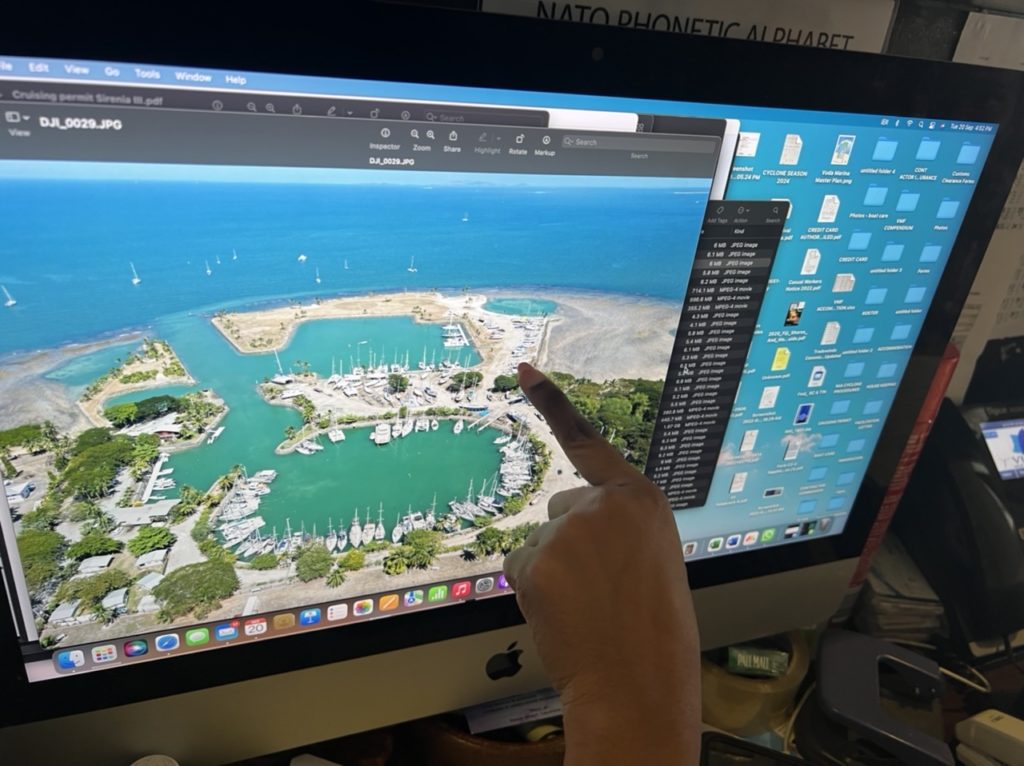
Between Rick and me, we made at least three trips to Lautoka, a fairly large city about 30 minutes from the marina, for boat supplies and beverage/food provisions. I fell in love with the vegetable and fruit market, very similar to what we have seen in Mexico. (I find it interesting that in the US, people have to go out of their way to “buy local,” whereas in so many other parts of the world like the South Pacific, large indigenous markets where everything is local is the norm.) We found almost every type of packaged goods we needed in their multiple, large, western-style supermarkets. Everything except red meat and fish, that is. (It seems there are specialty stores for those, and we haven’t found them yet.) And their alcohol was pretty darned expensive, without much variety. There is only one kind of beer that Rick likes here, and it’s availability is hit or miss. But compared to Tonga, Fiji’s provisioning opportunities are fabulous.
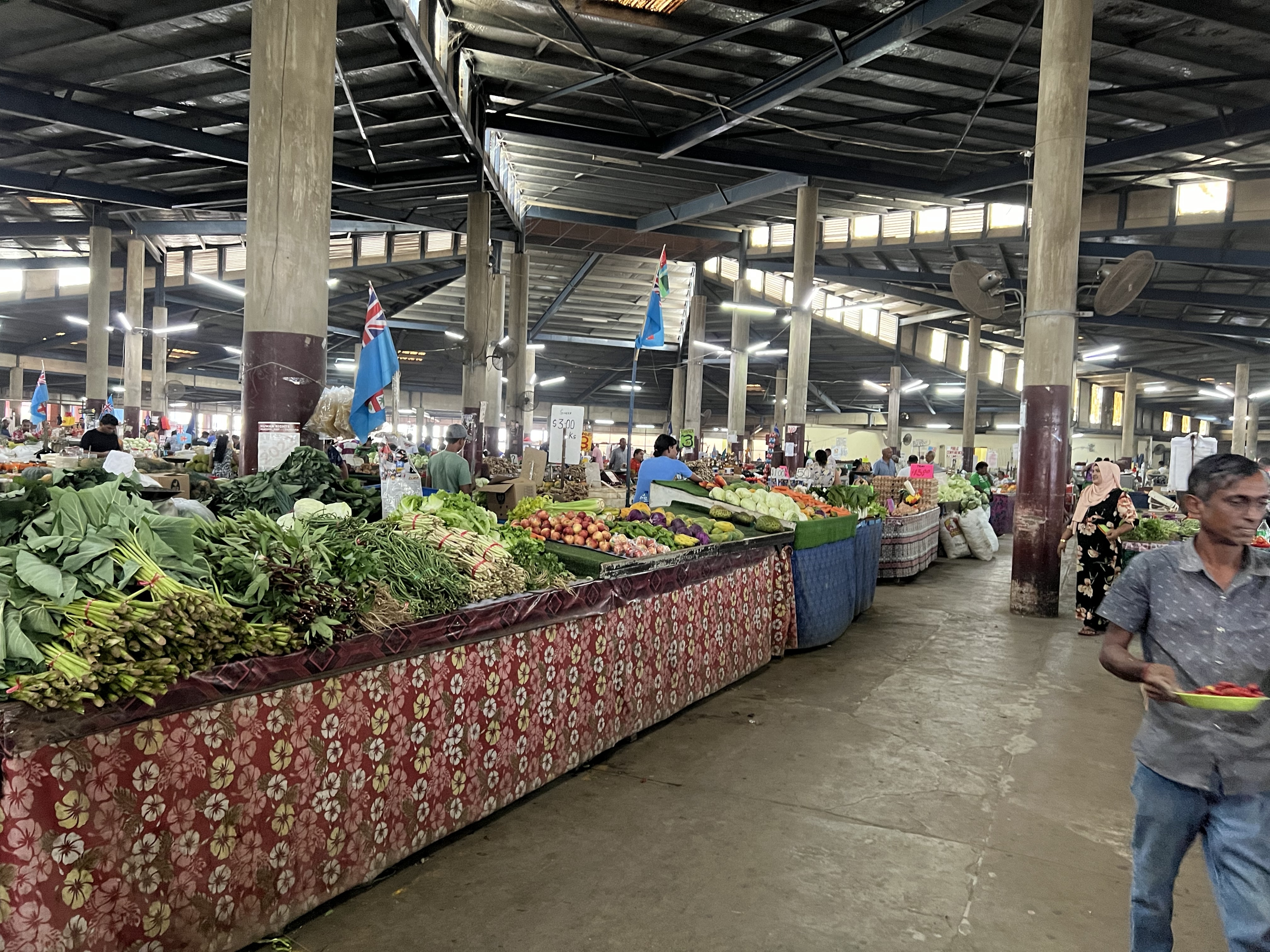
Our friend from Sausalito, Rob, came into the marina just a few days before we were leaving, with his brother-in-law JD. They were putting his lovely Oyster sailboat Shindig to bed in another pit and leaving for the season; Shindig’s crew had been in Fiji well before we were. It was nice to see familiar faces and enjoy a dinner together. We were also able to reunite with Scott and his partner Cat on Muskoka; we knew Scott from as far back as Mexico, and they crossed the Pacific from there in 2018, the same season we did. We also reunited with our friends from Tonga, Steve and Patty.
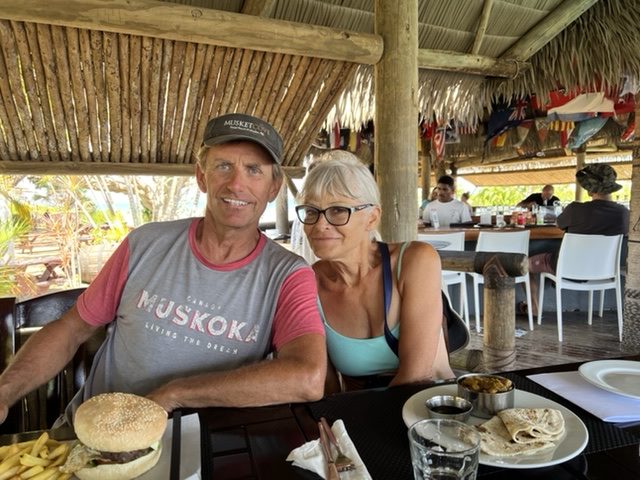
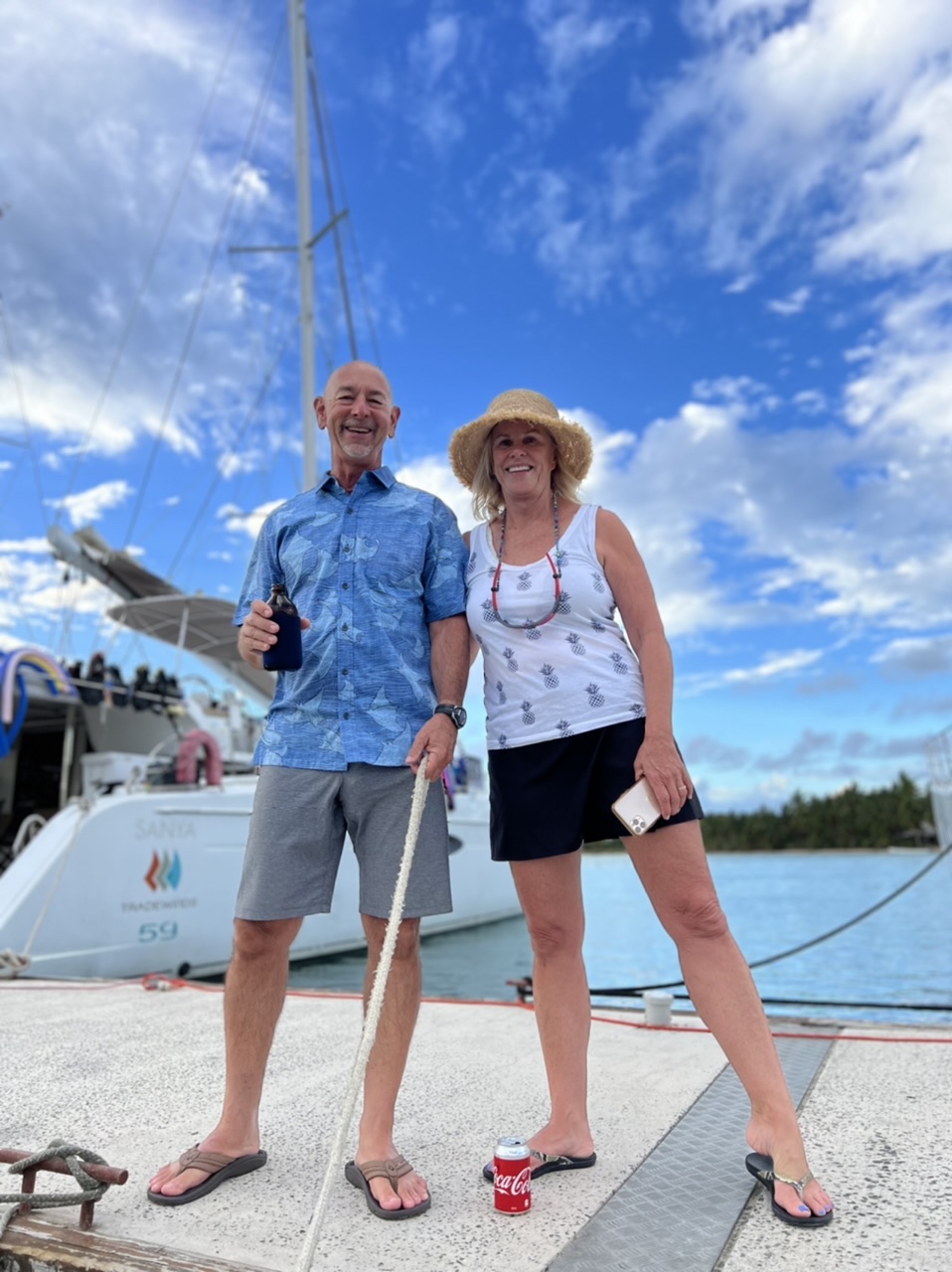
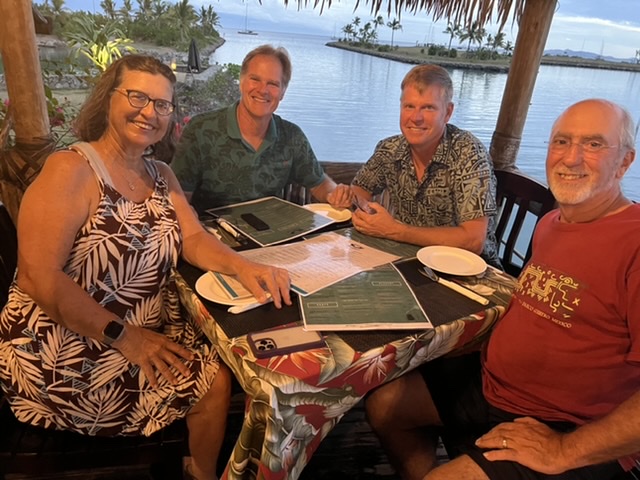
Speaking of running into boating friends, it was a total surprise and “Small world” experience (a double entendre, as you will discover) a few weeks later when I saw someone walking along the dock at Musket Cove who I recognized from Mexico! Craig and Cathy Small had a power yacht they called “Small Crew” that was in the Tenacatita achorage along the west coast of Mexico at the same time as we were. We had a “raft up” of dinghies in the anchorage at sunset, shared appetizers, had a talent show, and, well, one thing lead to another and we were invited onto their yacht. Cathy and I became friends of Facebook. That was years ago. And then out of the blue, Craig shows up on a dock in Fiji! They hadn’t sailed or motored here – instead, they flew here and chartered a sailboat for a few weeks. But it was really fun to see them, one of those completely out of context experiences that jars your expectations of what will happen next.
Once we final tore ourselves away from Vuda Point, we knew we only had a few months before we had to put Cool Change up for the season, and we had to stay close to our base in case one of the parties interested in buying our boat came for a visit. That left the two island chains closest to our base: the Mamanucas and the Yasawas. The closest Mamanuca island with ample sailboat amenities was Musket Cove, about a 15 mile sail from Vuda Point, so off we went. It was a lovely, clear day sail to Musket Cove, but there was either no wind or wind on the nose, so we motored. As we were to discover, the winds on the west coast shift several different directions in the course of a single day, making planning for a sail difficult.
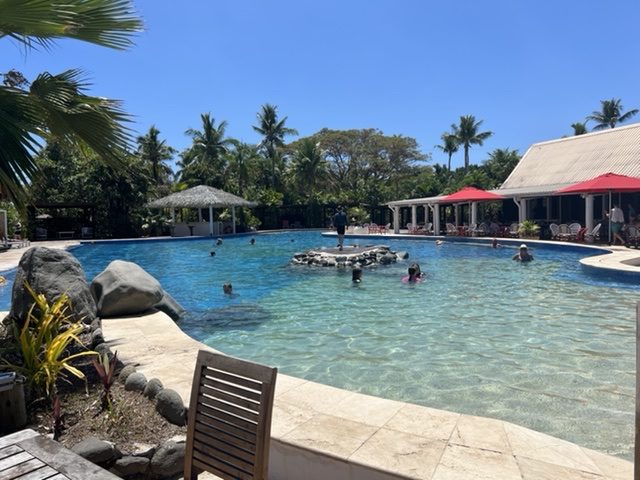
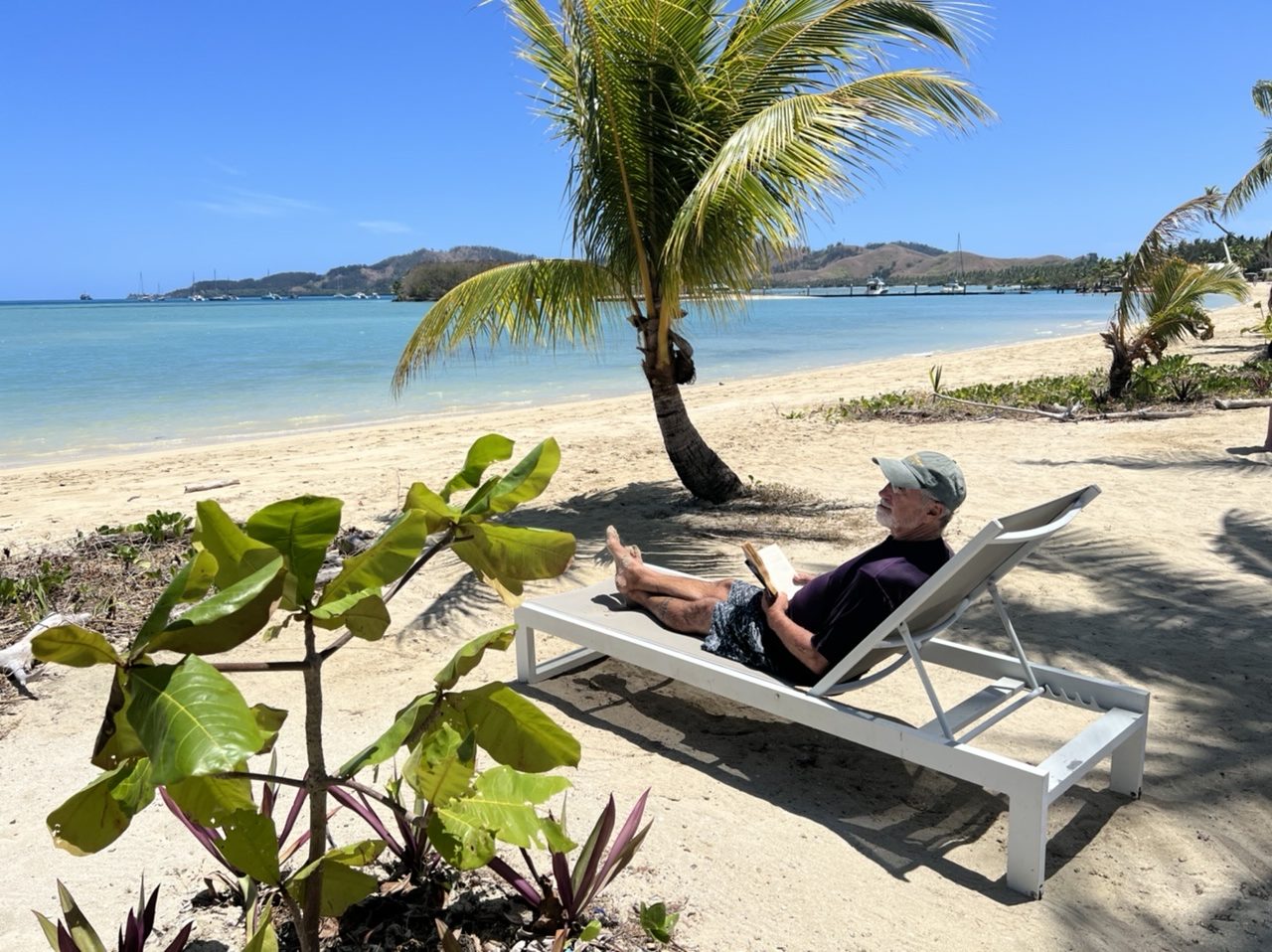

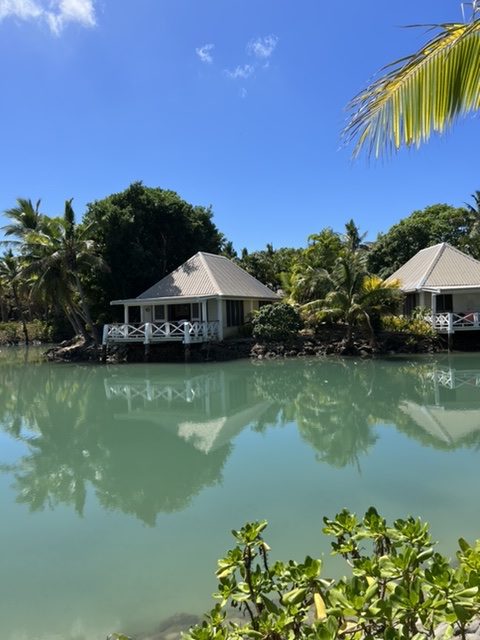
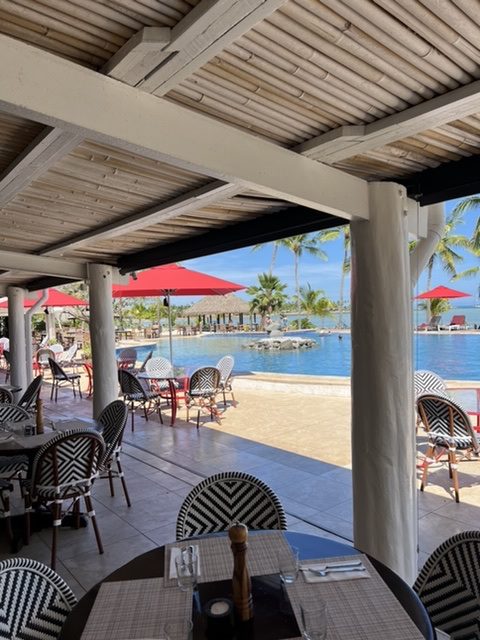
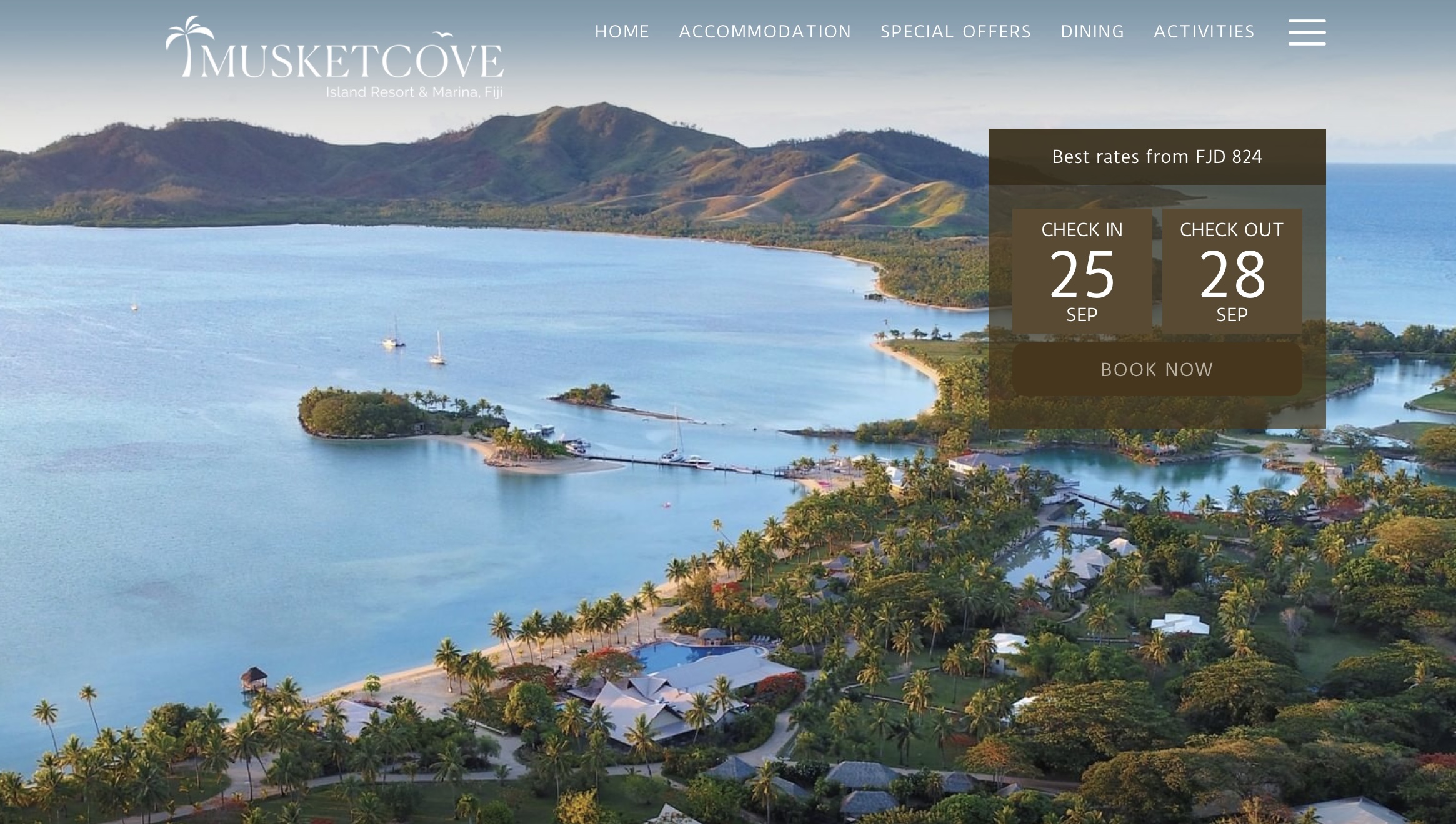
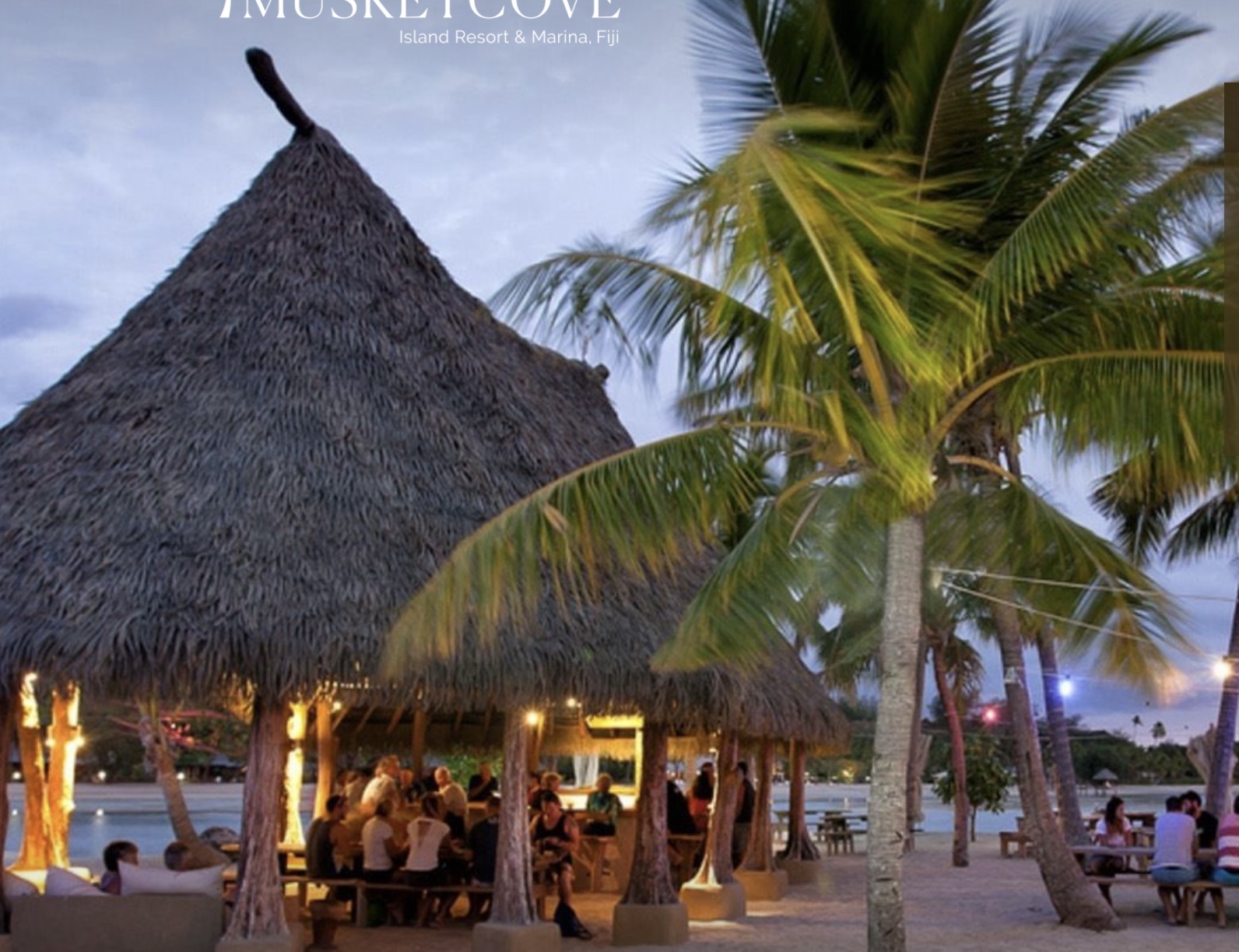
We were totally enchanted with Musket Cove. Not knowing the area or the anchor holding at all, we were relieved to find dependable moorings in the anchorage for rent for less than $10 US per day. The Musket Cove Resort is very welcoming to cruisers, and one can become a lifetime member of the Musket Cove Yacht Club for a mere $5 US. That membership gives you privileges to use all the facilities at the resort, including a large saltwater swimming pool, hot showers and access to many of their activities. We took advantage of their snorkeling package to let someone else besides us navigate the reefs and the anchoring around an absolutely wonderful snorkeling spot along the wall of a reef near the floating bar called Seventh Heaven, out amongst the reefs surrounding Musket Cove.

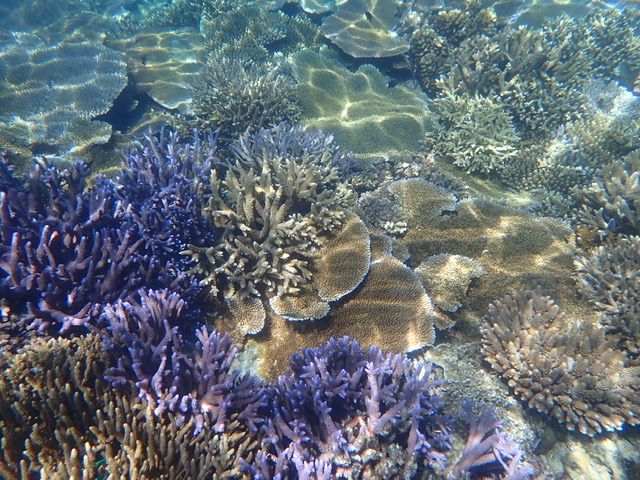


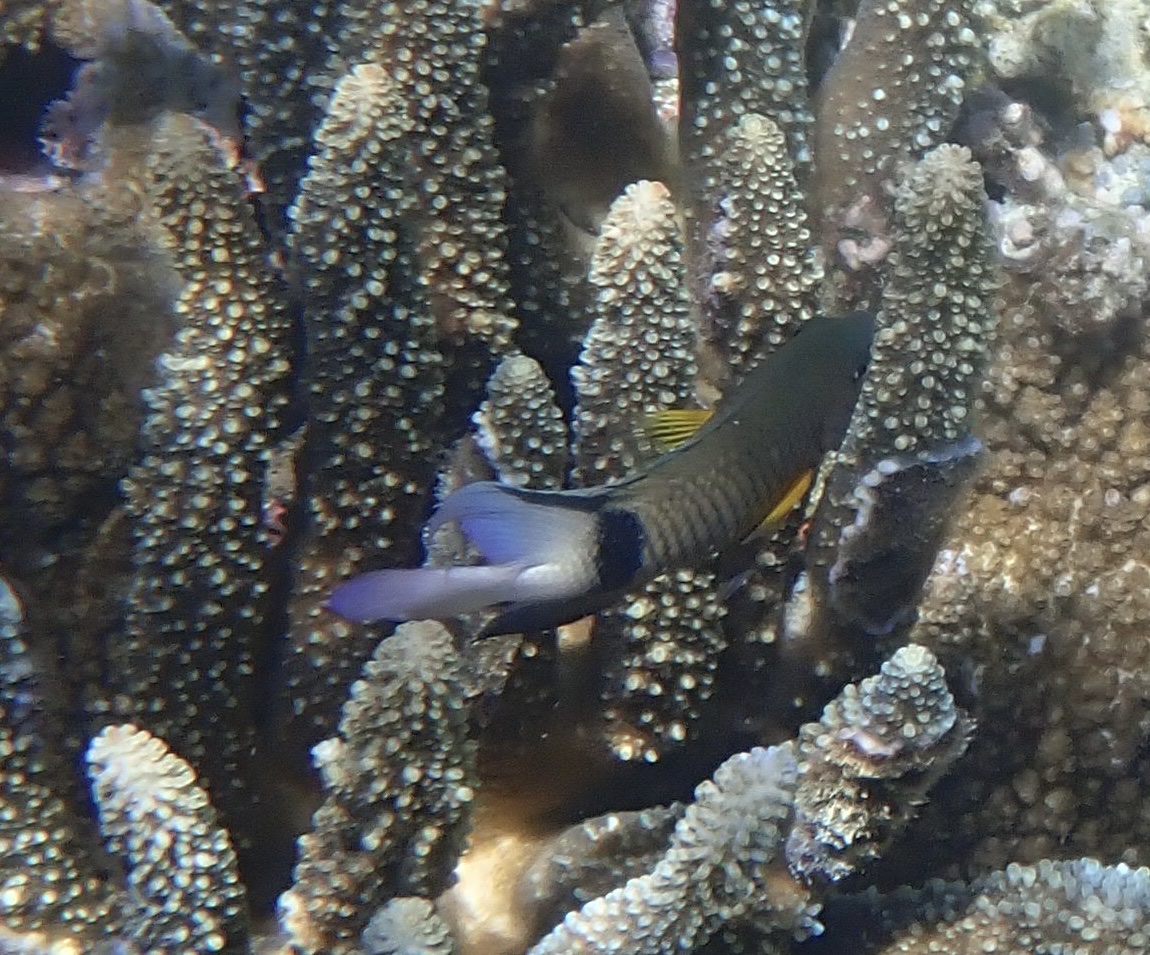
We had toyed with the idea of arranging for our adult children and their partners to visit us in Fiji this year, but we had pretty much decided it was too late in the season to try to make it happen, and we didn’t know enough about the potential destinations to choose wisely. But then our oldest son Dan asked us when he should plan on taking off work this year to come visit us! So we got to thinking: Musket Cove was the only remote island we had heard of where we could safely put Cool Change on a mooring while spending time with our kids, and it was close by the mainland, so why not Musket Cove? We looked into the resort and it was super expensive and not very available. But then, miraculously, we found a four bedroom house with private pool overlooking the resort, with full resort privileges, on Airbnb! We were lucky enough to find the home and were invited in by the owners to take a look around, and fell in love with the house. So quickly we put it out there to our kids and voila! it looks like it is coming together for the first week of November. Stay tuned for an update.
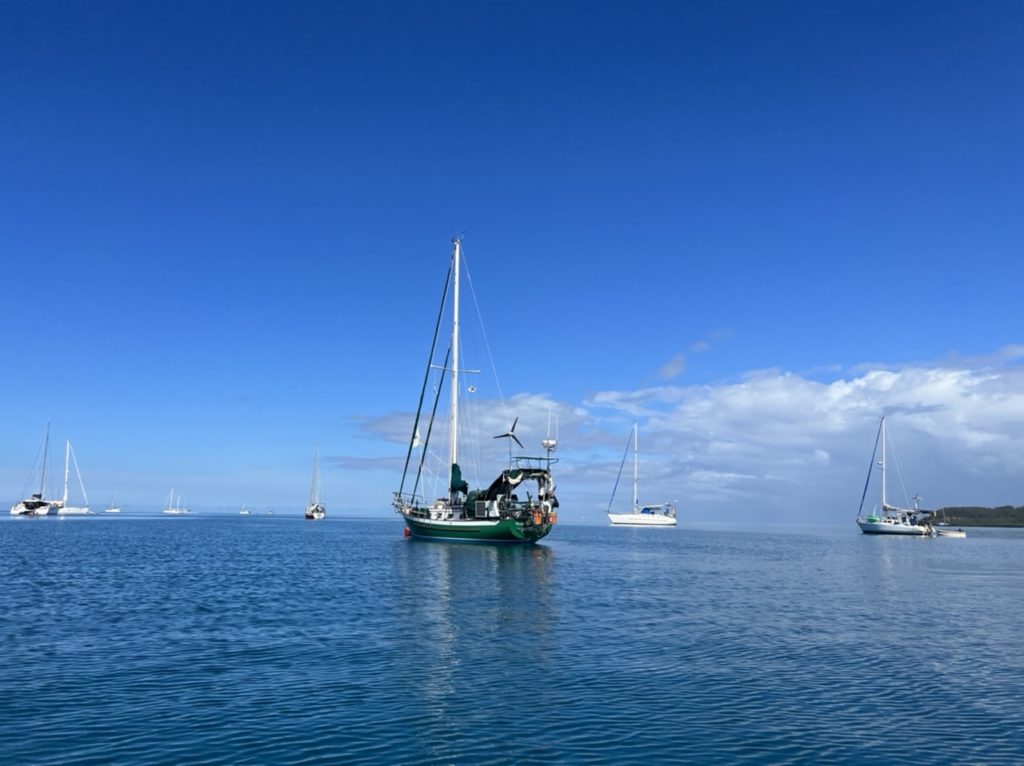

Besides the Musket Cove Resort, there is also Plantation Island Resort as well as Lomani Island Resort, an adult-only exclusive resort tucked away at the far end of the island. We walked through both and were not impressed with the cattle-car concentration of Australian families at Plantation, but the adult-only resort was an idyllic romantic hideaway for couples only.
After about a week in Musket Cove, we headed over to another island about 10 miles away called Mana. On our way, we swung by Cloud 9, another floating restaurant, to see how possible it would be for us to anchor there with the family. We think we can!

We skipped the reef-dodging route through another set of islands that would have let us pass by the island where the movie Castaway, with Tom Hanks, was filmed, but maybe we will get there during our family visit.
The entrance to the Mana anchorage is through a narrow, winding cut in the reef but it is well marked by sticks as long as one of us is at the bow to watch the color of the water and to determine which side of the sticks to follow! We entered just before high tide under the theory that we would be less likely to encounter outgoing waves in the pass, and sure enough, the water was flat. There were several boats in the anchorage but there was plenty of room for us.
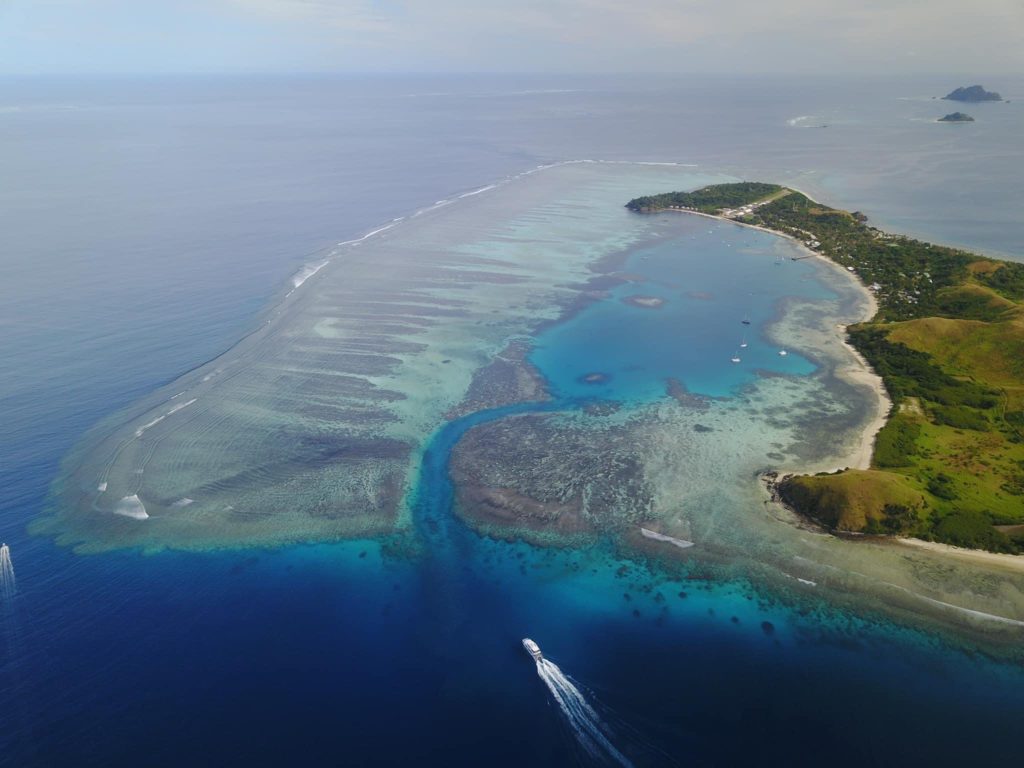
Mana has a little village and a few surfer/backpacker accommodations owned by the villagers on one end of the island, and the large Mana Island Resort on the other end of the island. In the village we found a cute little modest cabin facing the beach that would be perfect for our son’s family to stay in after we leave Musket Cove, something they requested we set up for them. It is a far cry from the comparative luxury of Musket Cove but will give our son Dan’s nine year old girls a better feel for the real Fiji. We spoke to the school there and hope that our granddaughters will get a chance to sit in on a class too.
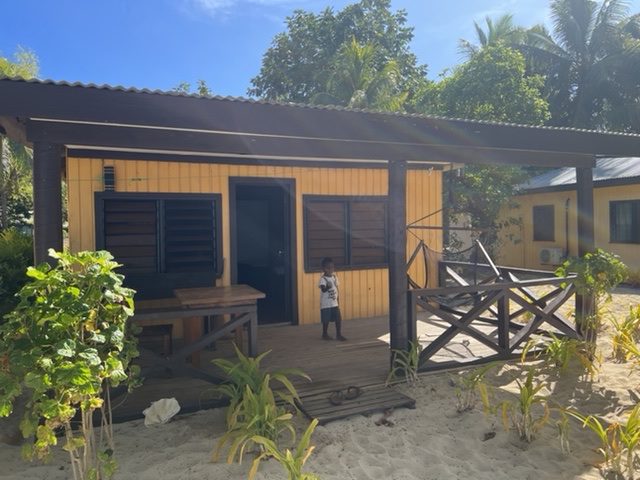
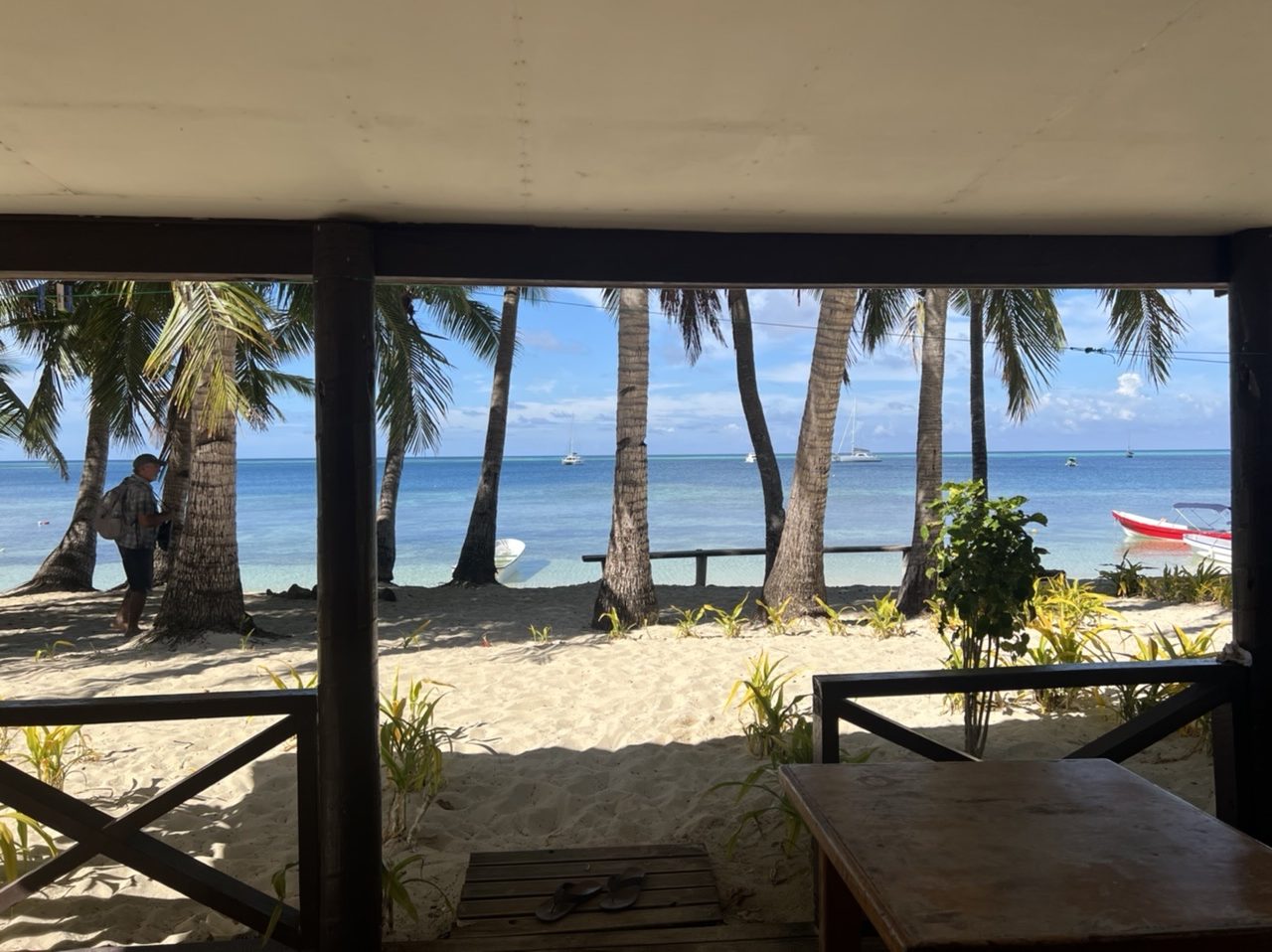
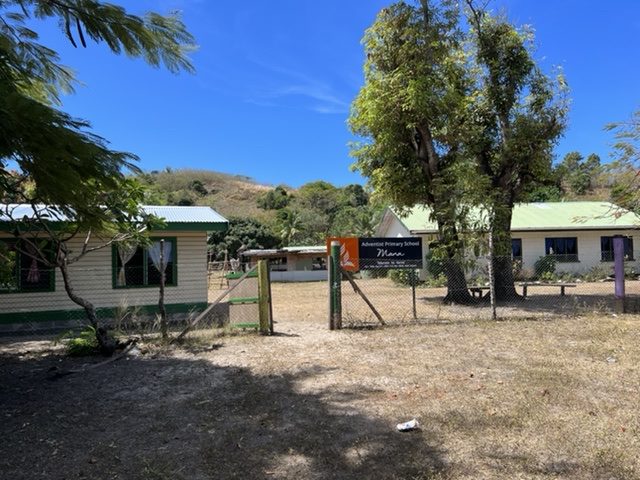
On the other half of the island, we found Mana Island Resort, an all-inclusive resort containing acres of little cabins with several pools and restaurants, a private snorkeling beach, and lots of activities planned for every age group. We had to pass through a gate and give our name to get in, and then check in at the main reception to obtain a pass. We had been told earlier that we should “dress appropriately” or they may refuse us entry. Then someone greeted us with a golf cart to scurry us off to the main resort activity area. They have made a point of being as much removed from the village as possible, going so far as to construct a big fence that keeps the villagers out. The workers live on the resort property rather than in the village. The resort is set up so that no one ever leaves the resort grounds; there are miles and miles of deserted beaches on the island yet all these tons of people in the resort never go out to explore them. We talked with the village ladies selling their small souvenirs on the beach and you could see how heartbroken they were to watch ferry-loads of people disembark every day for the resort without anyone ever coming down to visit them. Unlike other resorts we have since visited, Mana Island Resort did not invite the locals to sell their souvenirs inside the resort. I paid for a massage on the beach given by the ladies, and we bought some souvenirs from them, mostly because we felt the need to contribute to their economy. The school told us that the resort does not share their water with the village either, and that due to the current drought, the school has had to pay for water brought by the ferry just so the students have water to drink while they are in the hot, non-air conditioned classrooms. (We later discovered that this practice of excluding the locals is not universal, and several resorts have a symbiotic, integrated approach to their local communities.)
Nevertheless, admittedly due to our white tourist privilege, we were treated relatively well by the resort. I can’t say they denied us anything. We took advantage of our access to the resort to enjoy their buffet lunch at a reasonable price, and we could have enjoyed the pools and lounges as well had we so desired. We will probably bring Dan’s family there on occasion, since the meal availability on the island is otherwise quite limited. Also, there are paths through the resort that lead to a good snorkeling beach and a lookout, places we are saving to visit with Dan’s family.
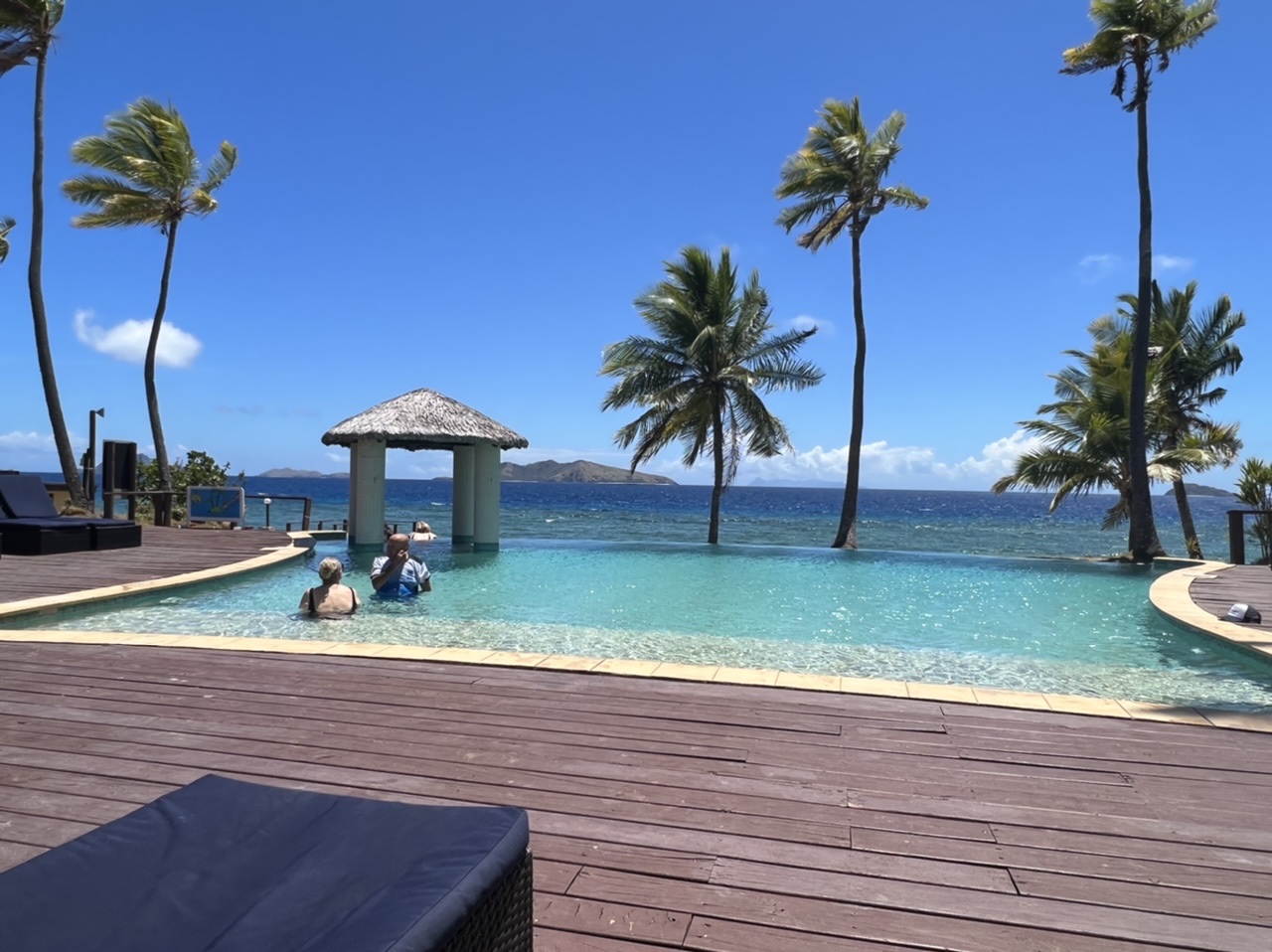
Our supplies were getting low and our dirty laundry was piling up. So we headed back to another marina along the “mainland” coast, called Port Denarau. It is a huge hub for all the ferries and boat tours departing from the mainland, and a marina for many super yachts. We weren’t able to get a slip or a mooring so we anchored out in some very blustery conditions, waiting for it to calm down enough to drive our dinghy into port. Once there, we found some nice do-it-yourself laundry facilities, very modern shower and toilet facilities, two well-stocked grocery stores, a bakery and several restaurants and bars. There are condos and multinational hotels there too, all on an artificially created island: a city in itself. The marina staff were quite accommodating. We found that the slips were about the same price as Vuda but were actual slips, with fingers, instead of a modified med-moor system. We made slip reservations there for the days preceding the arrival of the first of our kids, and also for the days preceding our haul out at Vuda. (Vuda does not take reservations and we definitely need fresh running water for decommissioning so we decided on the sure thing of Denarau.)
We finished our laundry, got our shopping done at two well-stocked grocery stores in Denarau, and had a “frozen coconut margarita” at a restaurant/bar overlooking our dinghy, all in one day, and decided that was enough of Denarau for now. We would be back. Instead, we were anxious to go explore the other nearby island chain, called the Yasawas.
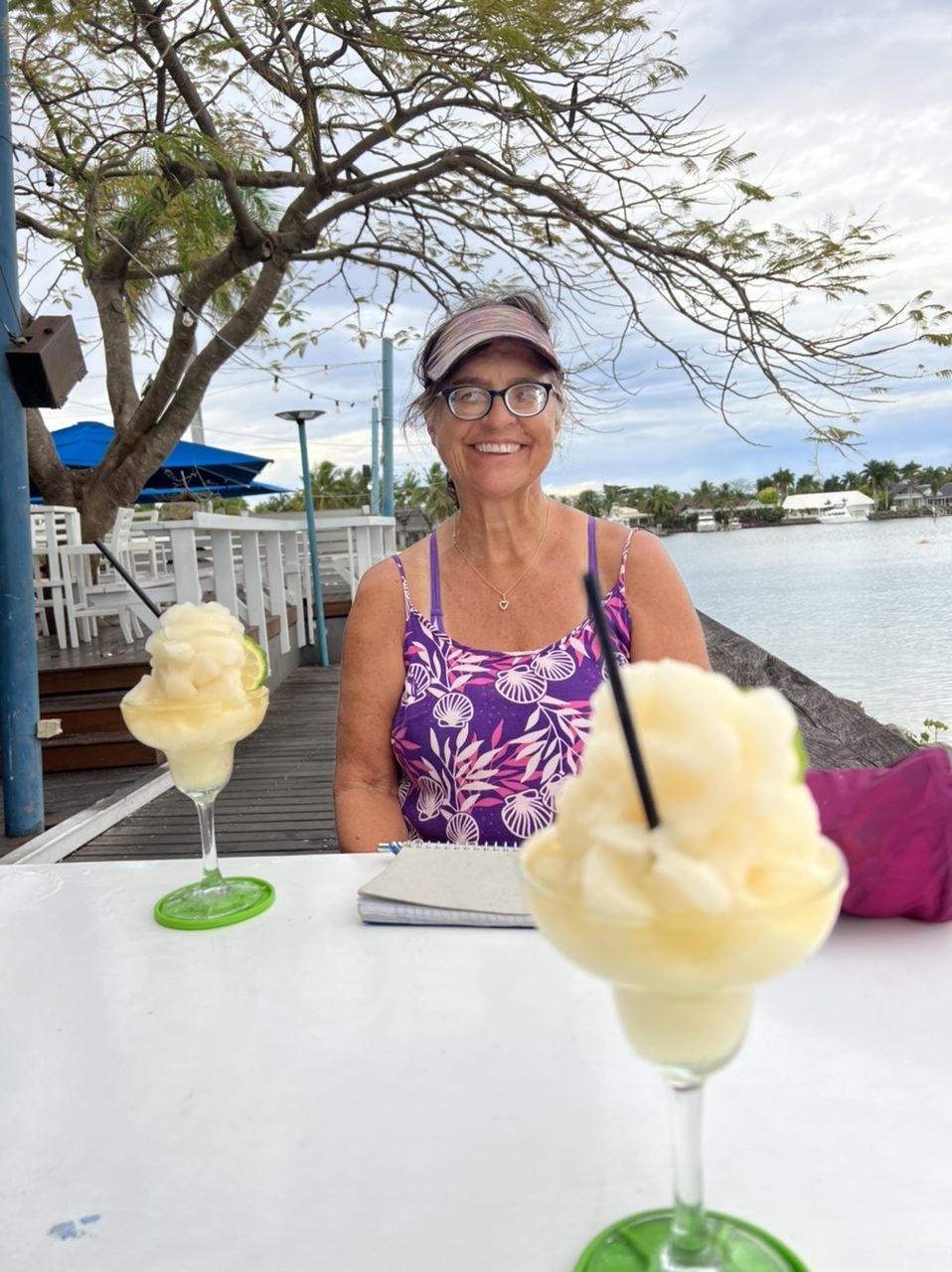

We barely knew where we were going when we headed off for the Yasawas. We had read and reread the cruisers’ updated online highlights of the area, and had seen Facebook updates from others, but it was hard to tell one bay or one resort from another until we got up into the Yasawas and experienced them. We had a Sail Fiji app that gave us some routes through the scattered low lying islands and reefs to get there, but everything was all a bit too approximate for us to be certain. Then we got out there and understood why. Everyone kept telling us that you can’t rely strictly on your electronic charts when sailing in Fiji, and that you had to use some form of satellite imagery as well, in order to spot the shallow parts. Fortunately, our friend Scott had warned us of this early on and had simply said to use Google Maps in satellite mode! So I downloaded Google Maps for Fiji in satellite mode for offline use onto my iPad, and voila! we could see where the shallow water was. The whole area we were sailing was no deeper than about 200 feet, for miles and miles, and reefs were everywhere, often uncharted. Unless a cloud was obscuring the satellite photo, usually the shallow places were visible as lighter-colored water on Google Maps. They often, but not always, were also identifiable by waves breaking on them. This meant keeping a watchful eye at all times, and not just counting on the electronic charts to trust you are in deep water. Even the Sail Fiji app, when giving waypoints, says, “Waypoints are indicative at highlights on the route. They are NOT a continuous route.” WTF? I surmised that to mean that all of these waypoints are places you are safe to go to but the passage between them is not necessarily a straight line, because you must constantly dodge reefs. When planning a route, that is NOT helpful!
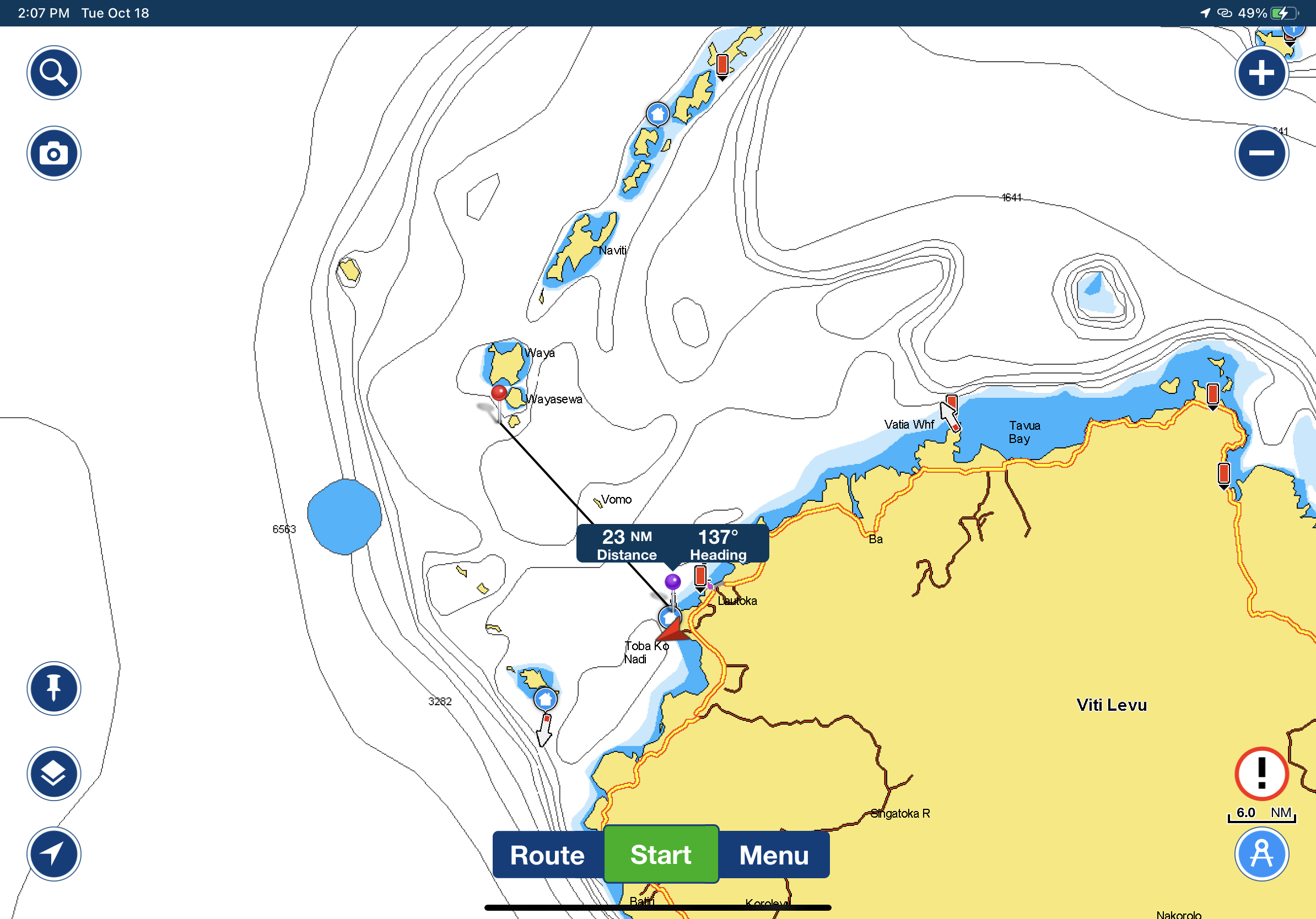


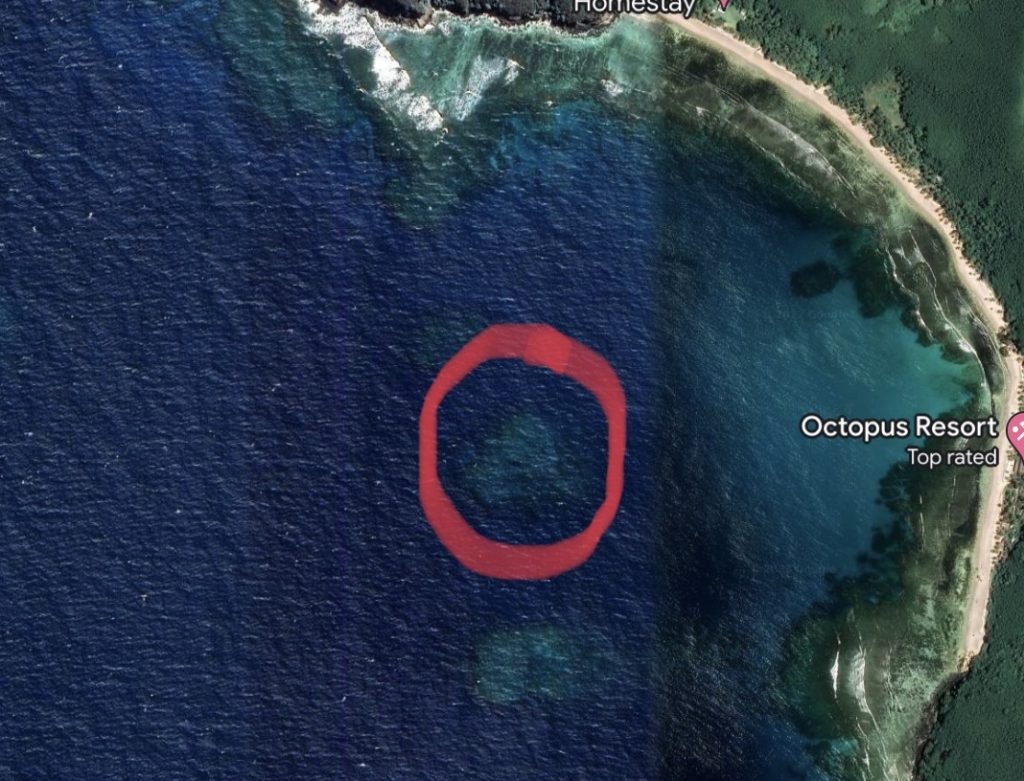
There are anchorages all along the western (leeward) side of nearly all the Yasawa Islands, so once we approached one of the southernmost islands, we started looking for a place to anchor for the night. It was a 30 mile sail to get there from Denarau, and we made pretty good time, arriving in less than six hours. We departed early enough that we had plenty of time to anchor and get settled before dark. That first anchorage was lovely. Unlike the lower elevations of the Mamanuca Islands or any of Tonga, this island had a lush, steep, green backdrop, with high cliffs. It was at the southern end of an island called Waya, in a bay called Yalobi. It was about five miles short of the first resort we wanted to visit, called Octopus Resort, which was reportedly friendly to cruisers.
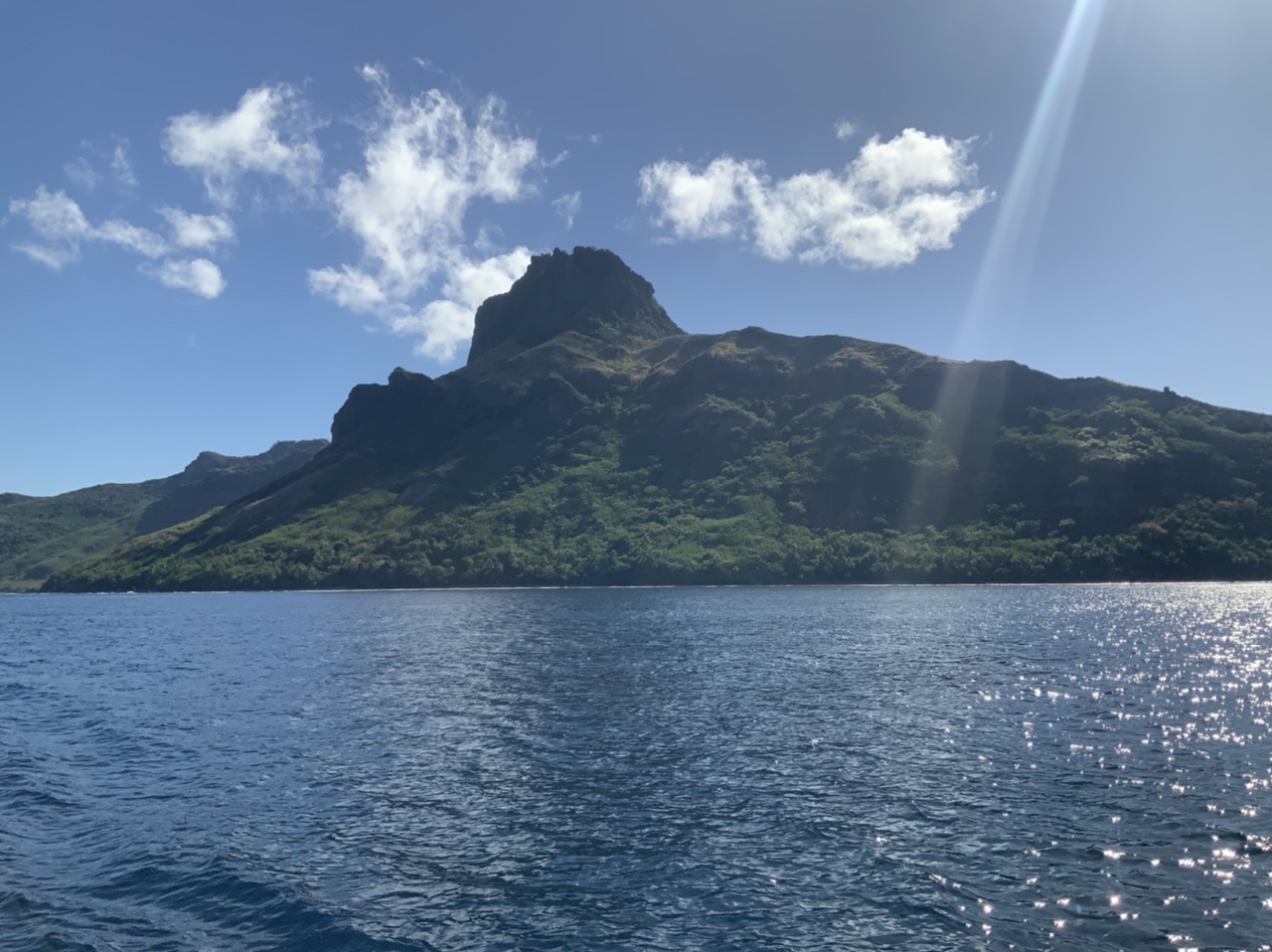
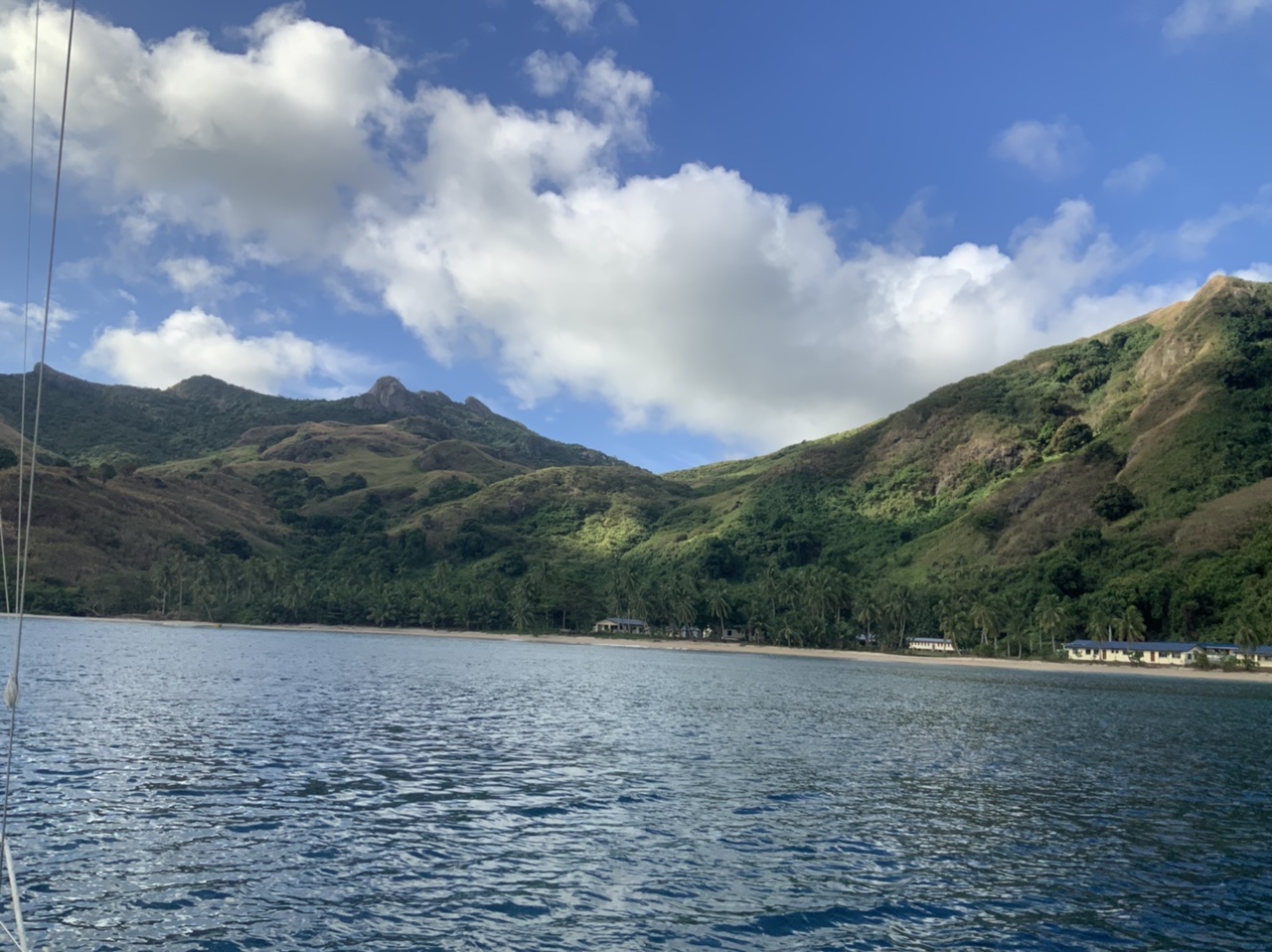
I was rather surprised once we got there that there was no cell reception, since I had been promised that cell reception was everywhere in Fiji. I guess we were more remote than I had realized, or the steep mountain made cell reception less certain. I was a little disappointed because it meant I was going to miss my weekly Zoom call with my sisters the next morning. But the fact that I have mostly been able to make those calls every week since I arrived in Tonga was itself amazing, and I decided it was ok to forgive myself for missing this one, rather than insisting we press on. After all, I was in a remote anchorage in Fiji, for goodness sakes!
The next morning we sailed on up to Octopus Resort, and I caught the tail end of my sisters’ zoom call while underway! Yes, sailing up the coast of a remote island chain in Fiji, I had cell reception! That was fun.
Octopus Resort was the exact opposite of Mana island Resort. It was small and intimate. Women from the village were selling their souvenirs right in the middle of the resort next to the only pool, 90% of the employees of the resort lived in the nearby village, and the village chorus performed songs and dances for the resort guests. The resort was completely integrated with the community and they depended upon one another. Cruisers like us were welcomed like family – they had us leave a credit card with the office and then we could order anything to eat or drink that we wanted, enjoy the lounge chairs and swim in the pool. I loved it! The only problem we encountered there was that we had bad weather one of the two nights we were there, and were swinging all around on our anchor, with our wind generator being overpowered and putting on its squeaky brakes. I got little sleep and Rick got even less.


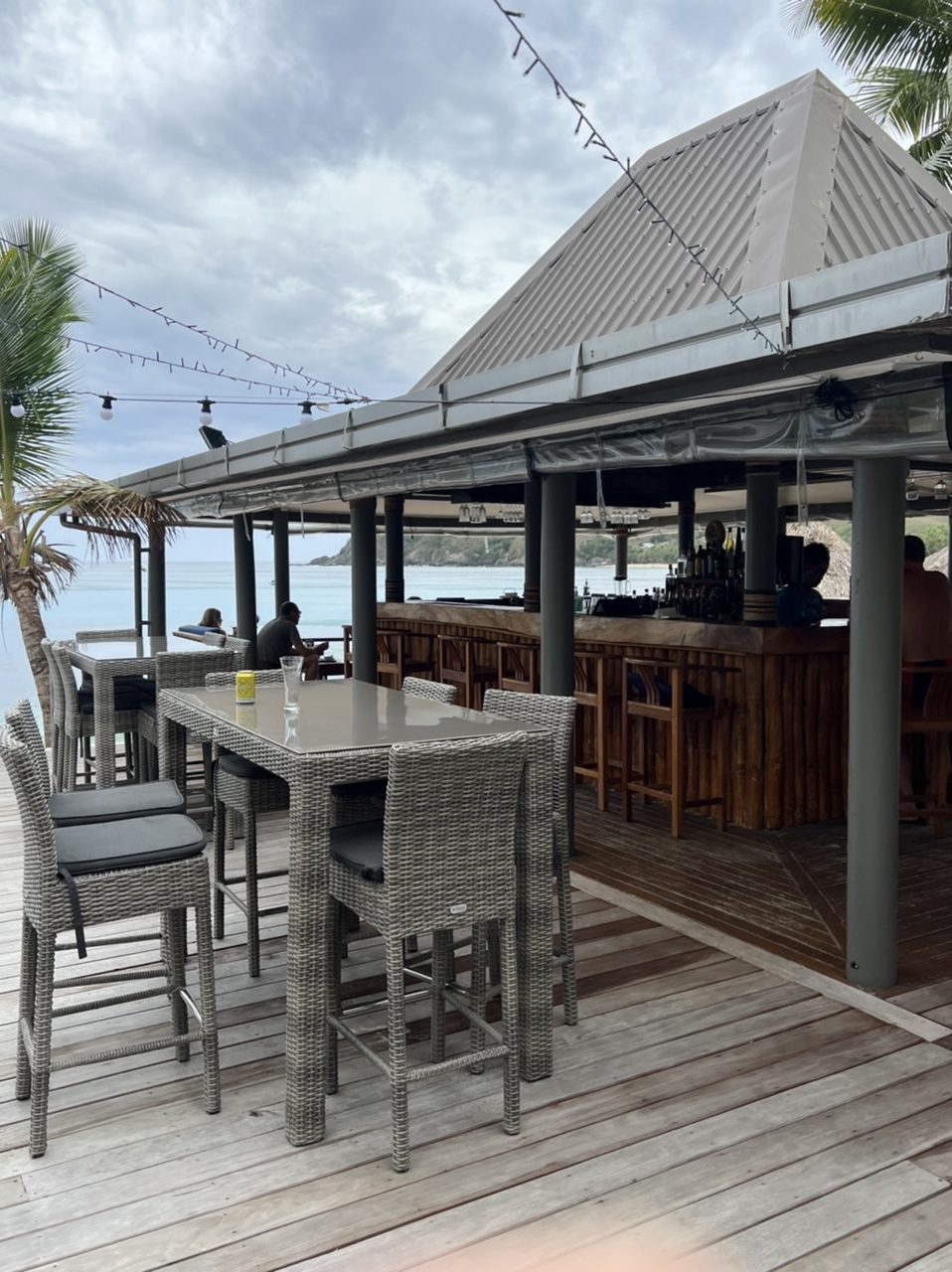
Not knowing when we might have to rush back down to the mainland for a prospective buyer for Cool Change, we felt we needed to press on north so that we could see as much of the Yasawas as we could before our time was up. In addition, there was a strong westerly wind predicted to arrive in a few days and we wanted to be in a more protected anchorage when that happened. So after only two days at Octopus, we headed up the coast another 30 miles or so. We passed by the anchorage where reportedly you can swim with giant Manta Rays and snorkel in a fantastic drift dive, partly because the we were told that the Manta Rays had already left for the season, and partly because we couldn’t afford the time to stop. We continued on to Blue Lagoon. Blue Lagoon is where the 1980 movie by the same name, with Brooke Shields, was filmed. It is a large, calm lagoon with several fingers, protected by islands on several sides. It was perfect for holding up in a storm. From just looking at the electronic charts, getting into the lagoon appeared to be tricky, with reefs everywhere, but the passes were wider than they appeared and most reefs were marked.
The principal Blue Lagoon anchorage contained about 14 boats when we arrived, down from the purported 40+ boats a month before. We were glad we missed them! We had barely anchored when we were welcomed by another cruiser on a paddle board. She answered a bunch of our questions and gave us an introduction to the lagoon. We also saw that our friends Sylvia and Tom from Cinnabar, who we had last seen in French Polynesia, were anchored in the lagoon too. We ended up getting together with them our last day there. Meanwhile, we took showers, cleaned ourselves up, went in for happy hour at the Boathouse Bar on shore and made reservations for dinner at the nearby Nanuya Island Resort.

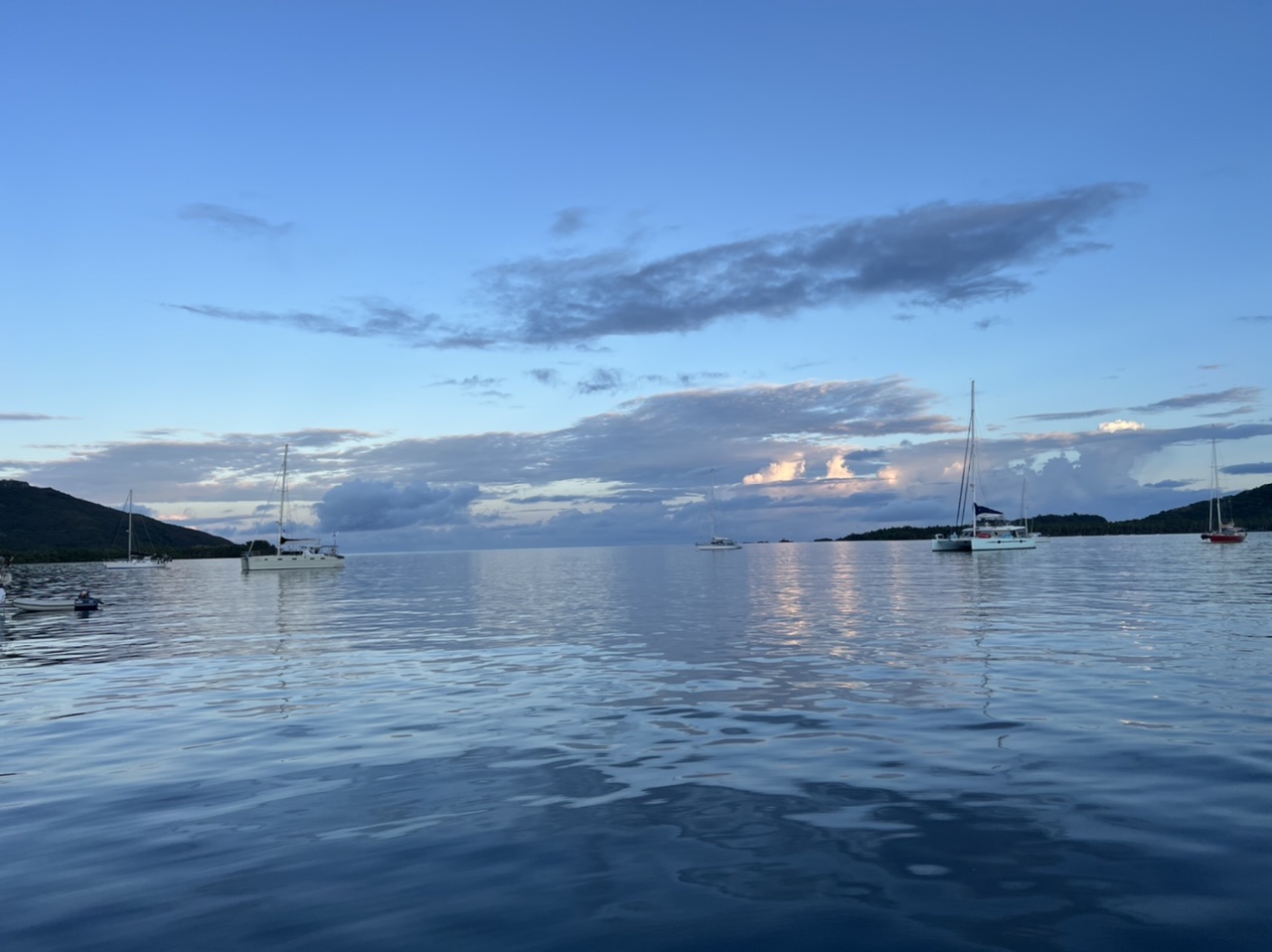
We were so happy to be at the Blue Lagoon. The anchorage was calm and protected. There was a small store with all the basics like eggs and bread and even frozen chicken if we ran low. There was a happy hour every night and you could buy wine for takeout and bring it home. My birthday was coming up and I was looking forward to going out for dinner at the resort. And there were lots of things to do! Snorkeling, hiking, and nearby caves were ready for us to explore!
After taking a day to get our bearings and walk the beach a little bit, the next day we made arrangements with a young couple with a small tour business, to take us to the Sawa-I-Lau caves. These caves were made famous by the Blue Lagoon movie, and tour groups go there every day, so I imagined they were fairly commercialized and safe. But my interest in going there was that the visit would include a quick dive underwater to get from one cave to another. I had always wanted to do something like that but was afraid that I would loose my breath or get lost before I found air! I was assured that this was just a three second swim towards the light, so, I thought, what could possibly go wrong? Haha!
We descended to the first cave, which contained natural light from above. We were warned that the cement stairs down to the cave were slippery and that we should bring fins because we would be treading water for a long time, and those tips helped us to avoid a mishap. We were fortunate that we had picked a day when no cruise ships were visiting, so there were just a handful of people, and only one other group in the cave with us. Our guides Navi and his Kiwi wife Molly, then prepared our small group of four guests to dive to the next cave. They explained that inside the second cave there was no natural light, but Molly and Navi had underwater flashlights. I didn’t have a waterproof flashlight, but I put my brightest headlamp inside a small, clear dry bag so at least I would have something to see with, or for others to see me.
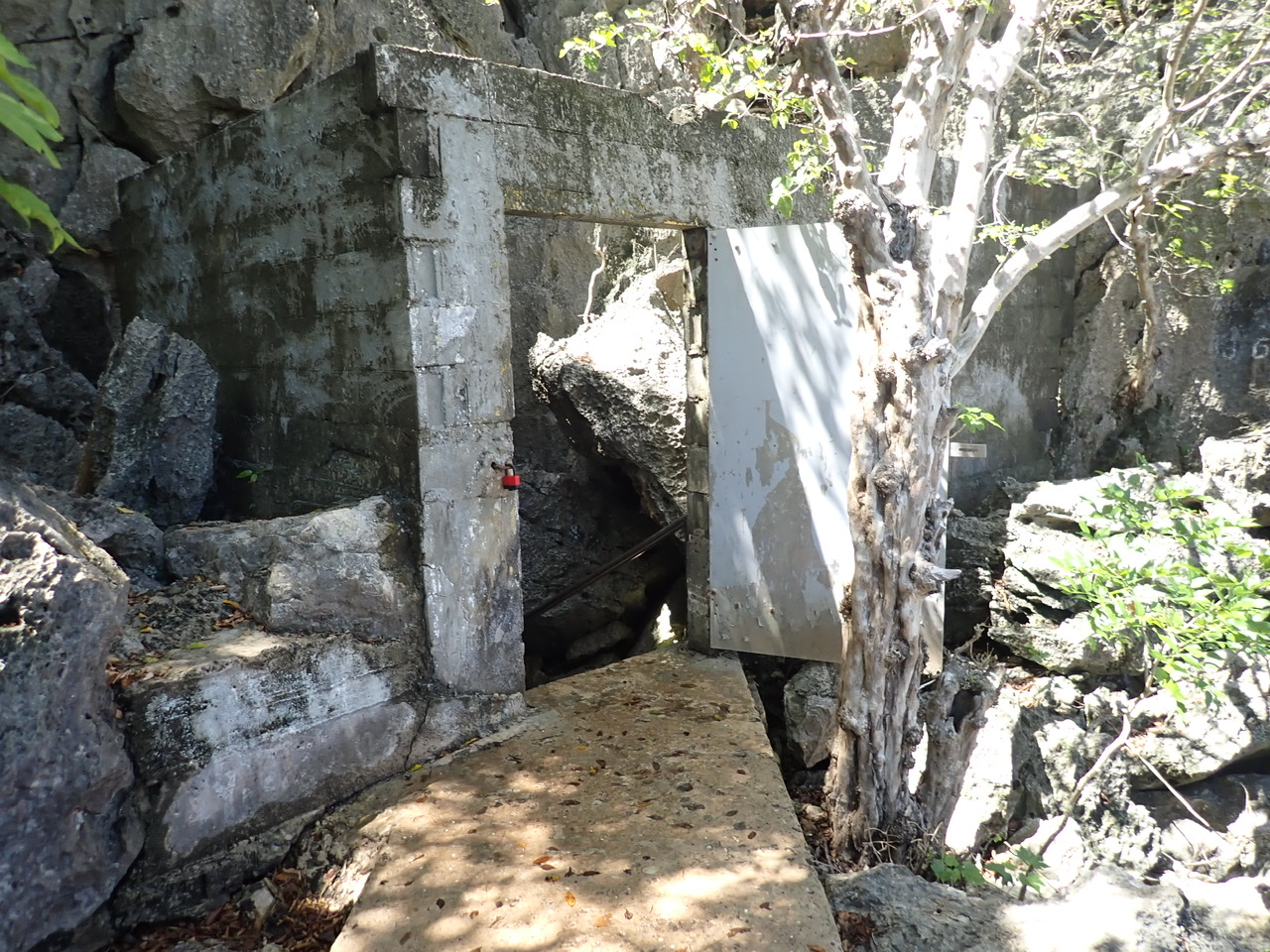

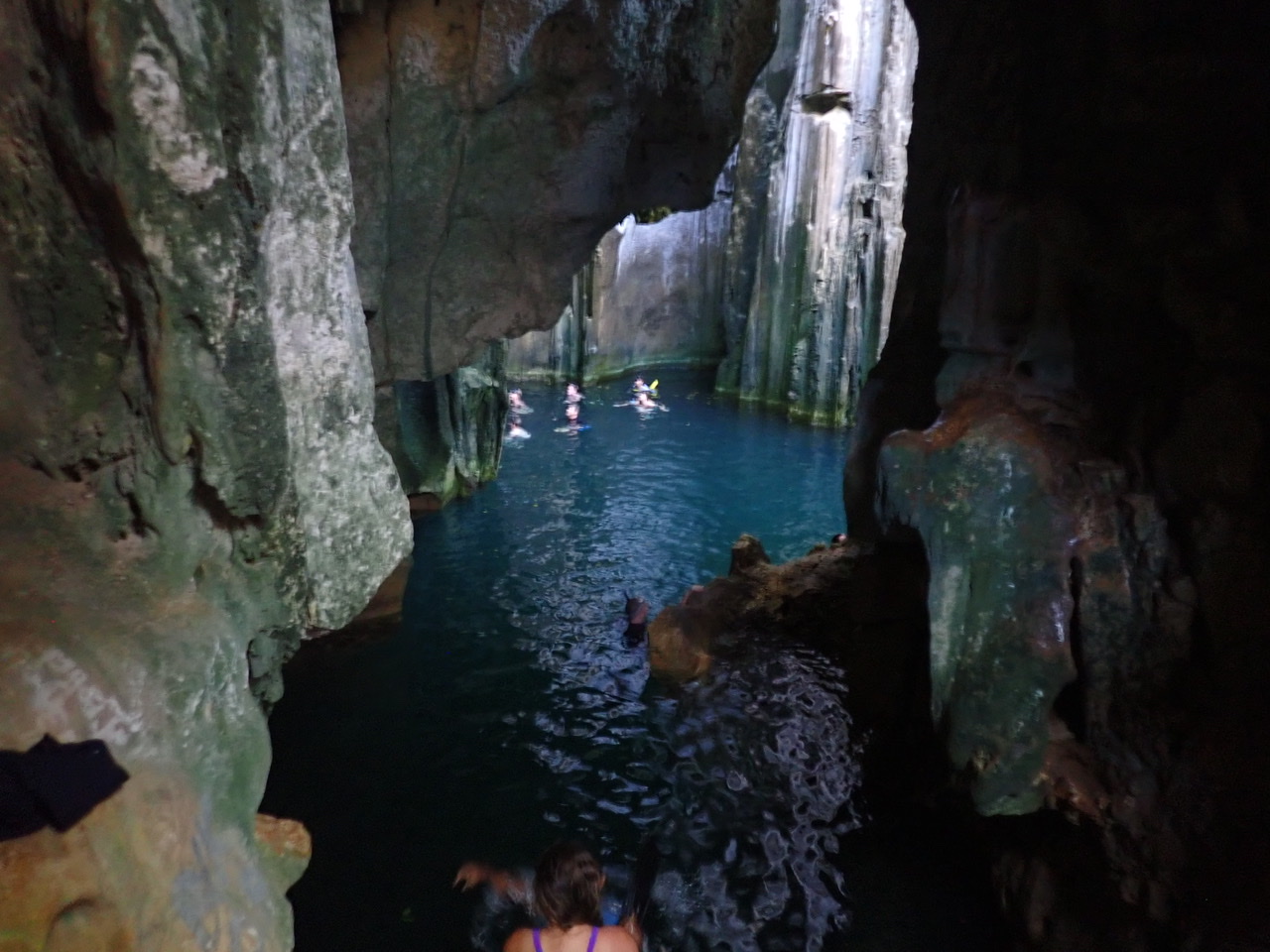
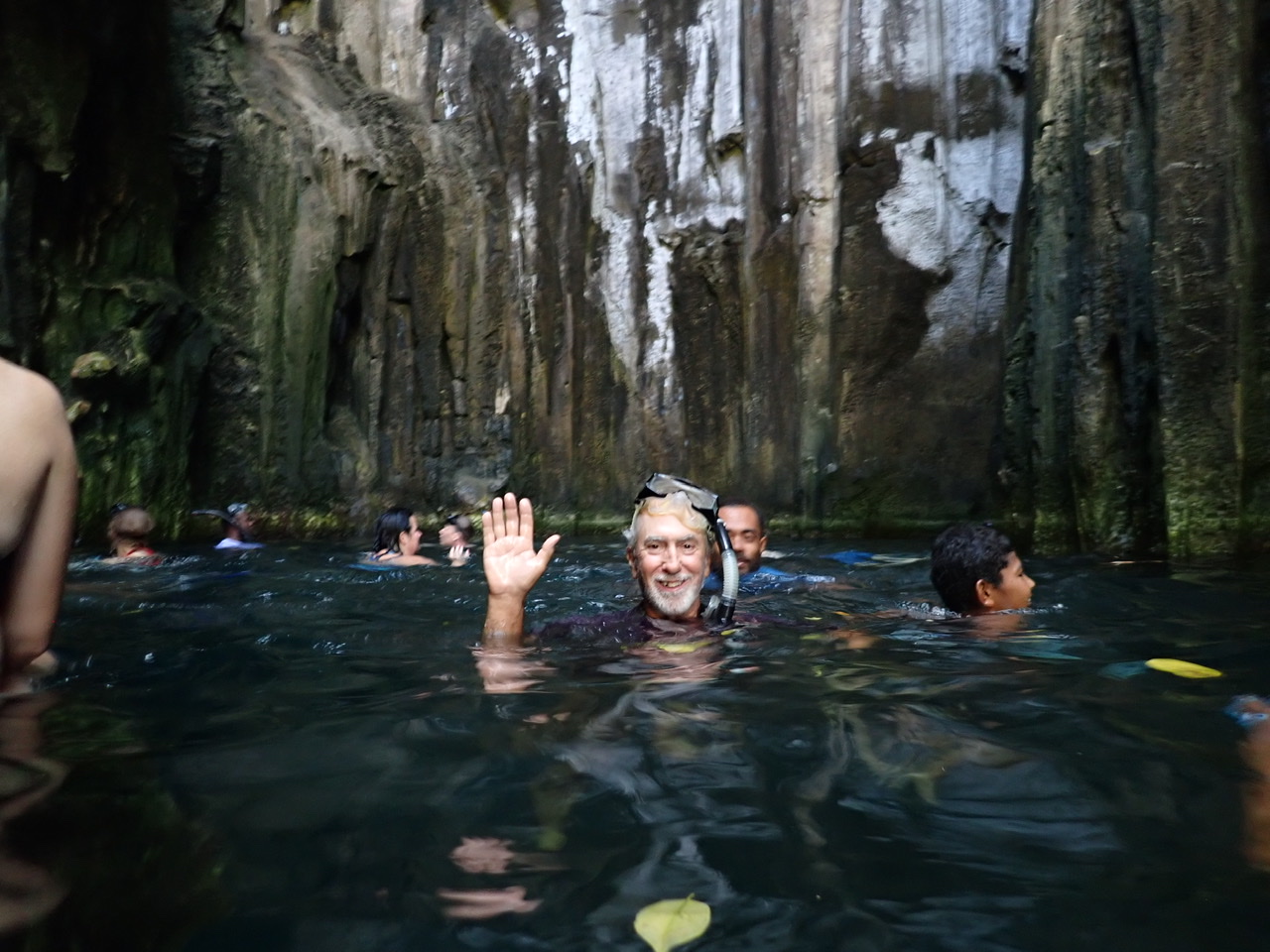
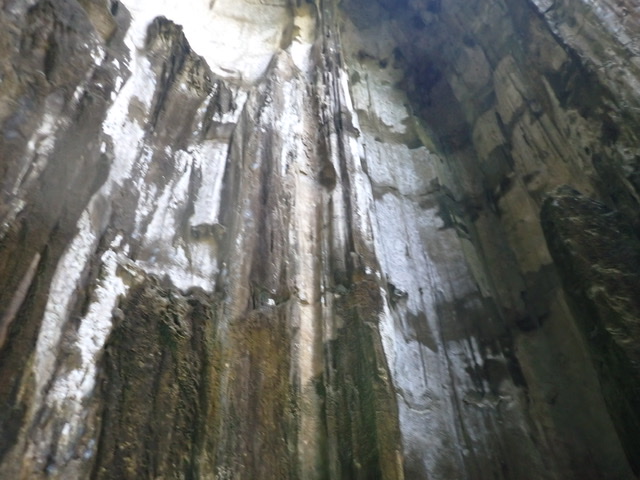
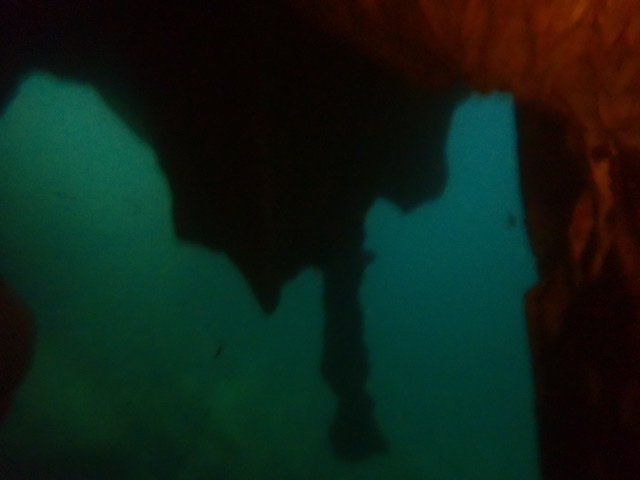
The dive to the second cave seemed pretty straightforward. From above, the entrance seemed quite narrow, but once your head was underwater, you could see the light on the other side and it didn’t seem that far. There was a large stalactite hanging down in our path, but I could see my way around it if I stayed deep enough. When I got to the other side, Molly or someone else with strong hands kept my head down for me until it was clear for me to come up. I made it! And so did Rick. The second cave was a lot smaller and you could touch the walls on all sides. It seemed likely you could touch the ceiling as well, although I didn’t, as though there might not have been enough space to breathe if it were high tide, but maybe that was just my impression. (I had asked about the fact that it was past low tide by a couple of hours when we went to the cave, but I was told not to worry). Next, Navi said, “follow my light,” and he took off into a deeper part of the second cave, through passageways and around bends. The two young Kiwi sisters in our group followed closely behind Navi, but Rick and I were somewhat further behind. Rick told me later that he hadn’t realized the group was moving until he was left alone and had to quickly catch up. I almost lost the group too, and I wasn’t sure where Rick was. I kept calling out Rick’s name but there was no response. Finally, once we were all gathered at Navi’s destination and he was giving us some history of the caves, Rick appeared. I was so relieved. It was hard to communicate inside the dark cave because there were echos, we had snorkeling gear on, and there was so little light.
The next thing I knew, Navi told us to follow his light again, but quickly he and the two Kiwis got too far ahead of me and I lost them. Thank goodness I had my little headlamp lit, because I was just about to panic as I was feeling my way around the walls of a small cave room trying to find an exit, when Rick found me and lead me to the light. And then there was the swim out. Somehow it seemed less direct than the swim in. I could see the light I was supposed to swim to, and I could see the stalactite, but I also saw that the woman ahead of me did not come up when she got to the light, but instead kept swimming underwater to the left. I didn’t like that idea much because I wasn’t sure where I was supposed to go once I turned left. Fortunately, it all turned out ok – I got to the light, was pushed to the left by the guy holding the light, and the next thing you knew, I was breathing air again.
Okay so I probably made it sound scarier than it was. I am sure Navi and Molly knew exactly what they were doing, and it was his cousin in the cave whose strong hands helped me through. Tons of people do this same thing every week, and I have come across no reports of bad outcomes or people getting lost. There probably was only one way out and if I had gotten lost, I would have been found in short order. The swimming underwater part turned out to be the least of my worries, and really wasn’t that hard, even at higher water – anyone can swim ten feet holding their breath, right? The guides seemed to think that the biggest danger was hitting your head by coming up too soon, so they made a point of keeping our heads protected. But even knowing all this, the thrill I got from this experience was more than I had bargained for! Yet it made me feel alive in a way that few experiences I still dare to undertake do.
To top off a really exciting day, Navi talked with Rick about fishing all the way back to our anchorage, and gave him a pole to troll with as we returned. Navi is a great fisherman and it was his skill that allowed he and Molly to survive the lack of customers through the COVID pandemic – they traded the fish he caught with others who had flour, sugar and other basic necessities of living.
Unfortunately, the bad weather did come to the anchorage the next day, so we hold up in our boat for a few days. The good news is that the anchorage was so protected that Cool Change was still. We had cellular data so we were able to complete our ballots for the upcoming California election and a few other housekeeping chores. It was nice to just relax. The day of my birthday came and it was still raining, but I woke up to sweet messages from all my kids and lots of kind words on Facebook, so those made my day even before we managed to get to the resort for dinner that night. By that time, it had stopped raining.
Our last day in Blue Lagoon, our friends Sylvia and Tom from Cinnabar took us on a hike to a home at the other end of the island where a woman named Lo makes donuts for cruisers! How fun was that! It was nice to get out walking, and great to catch up with Sylvia and Tom.
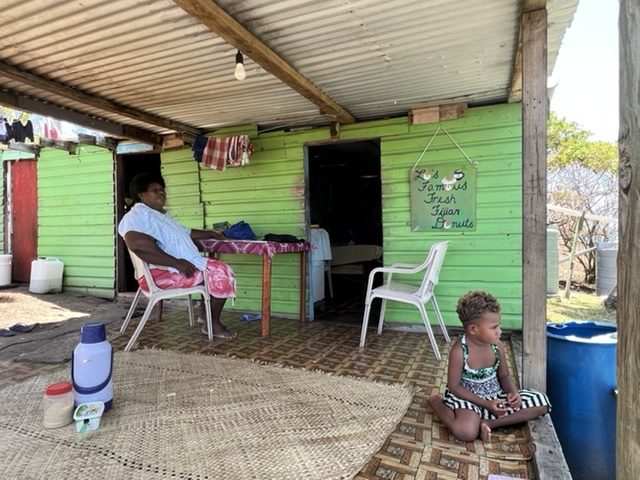
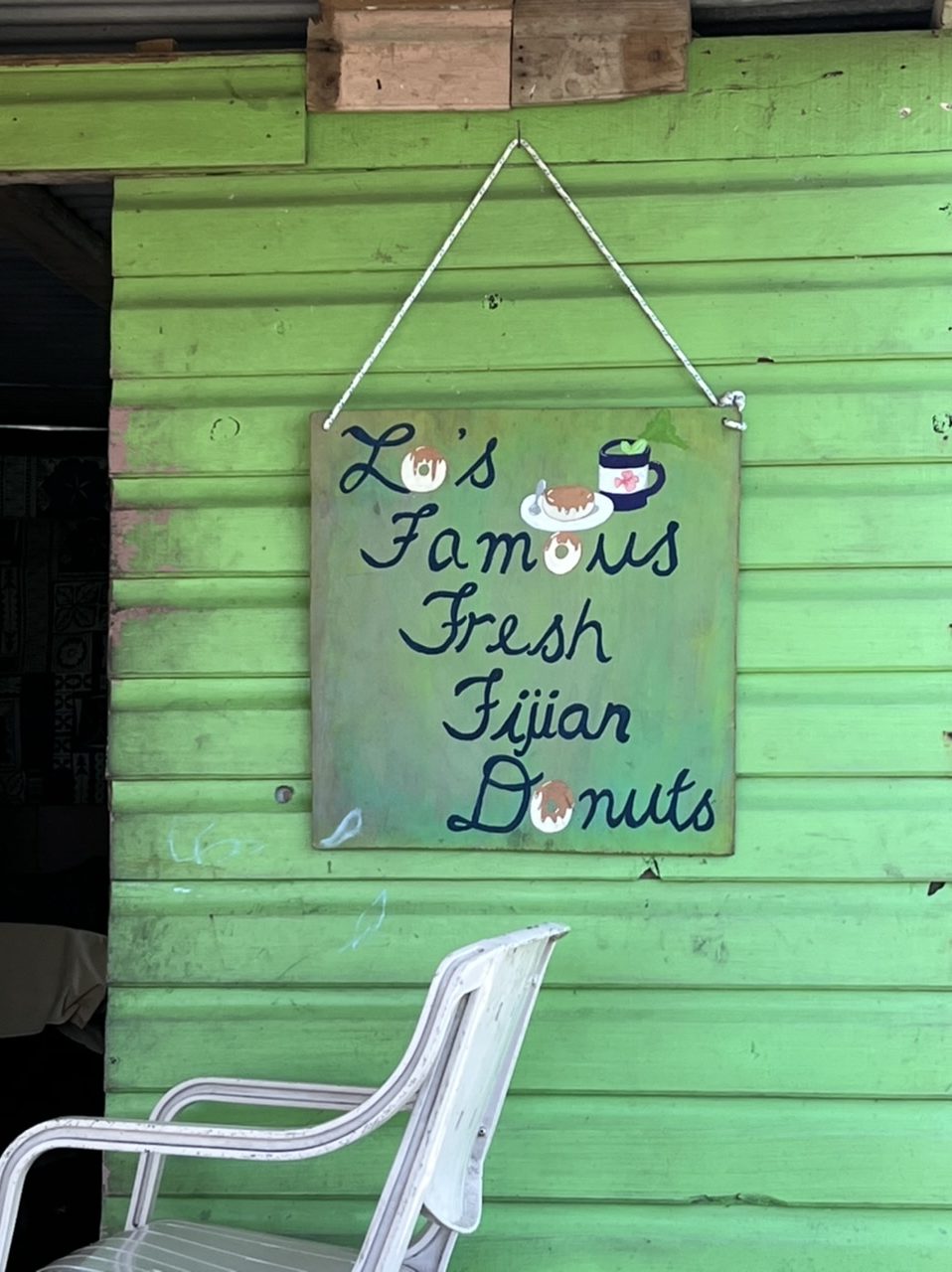
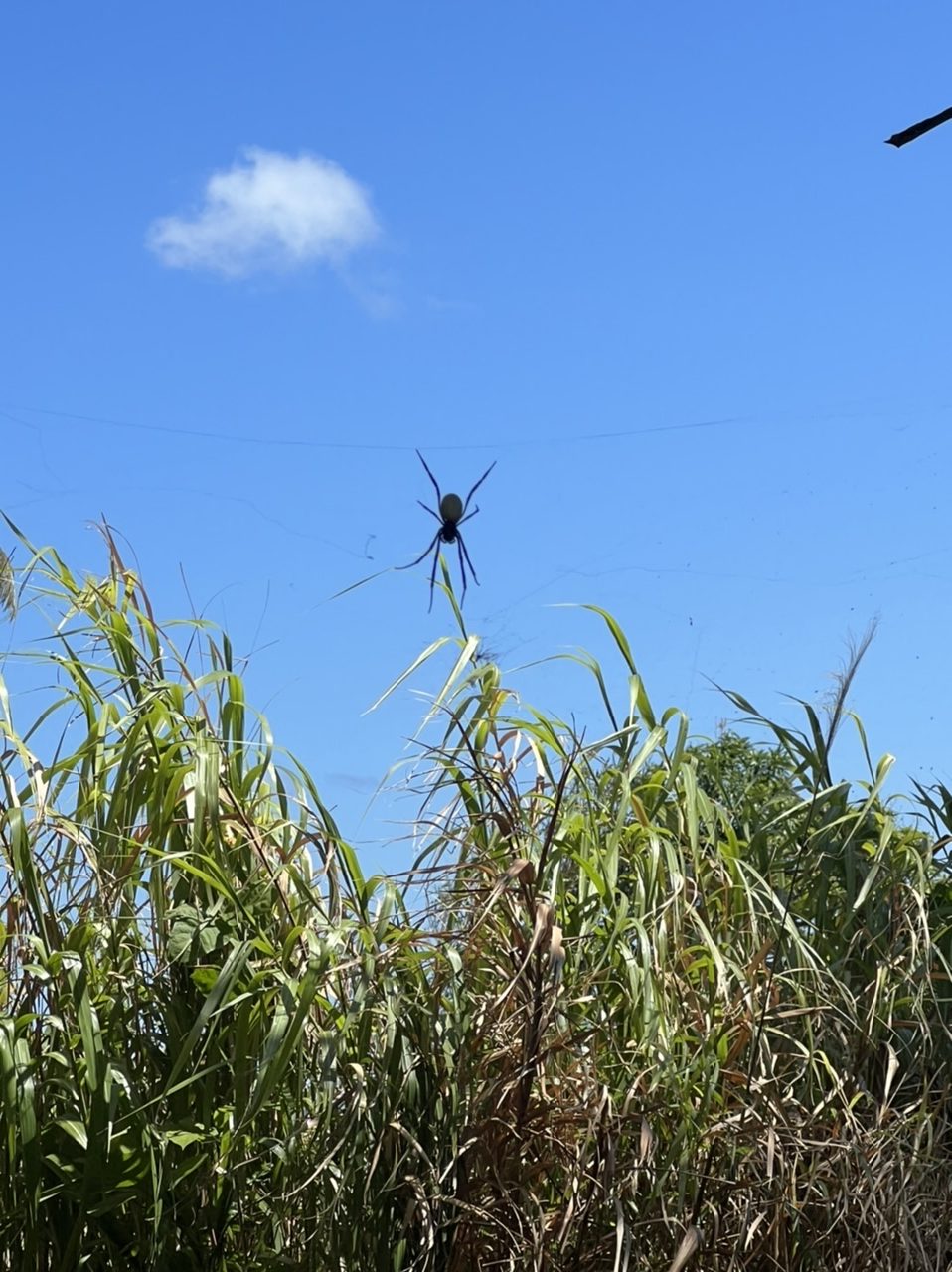
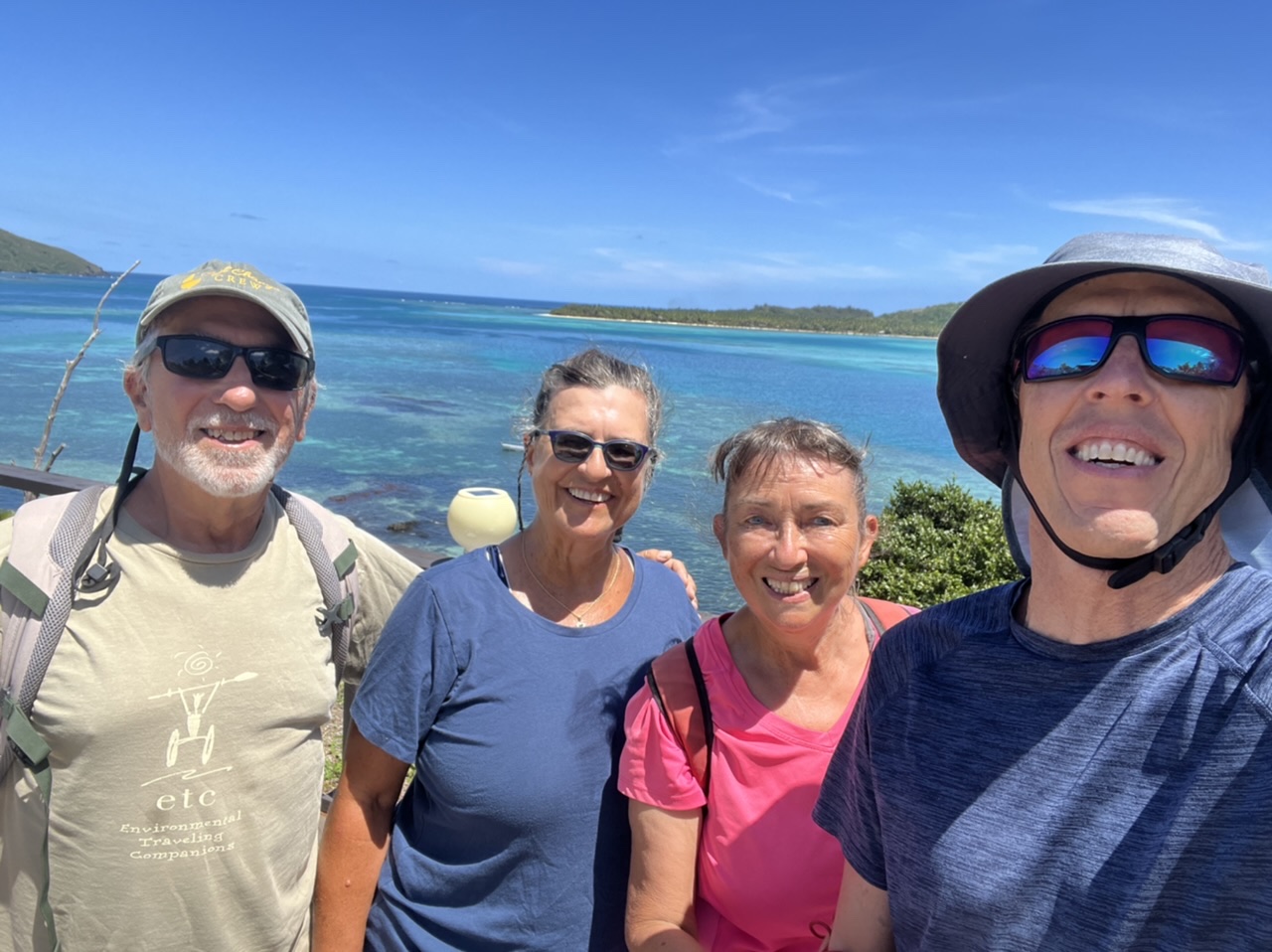
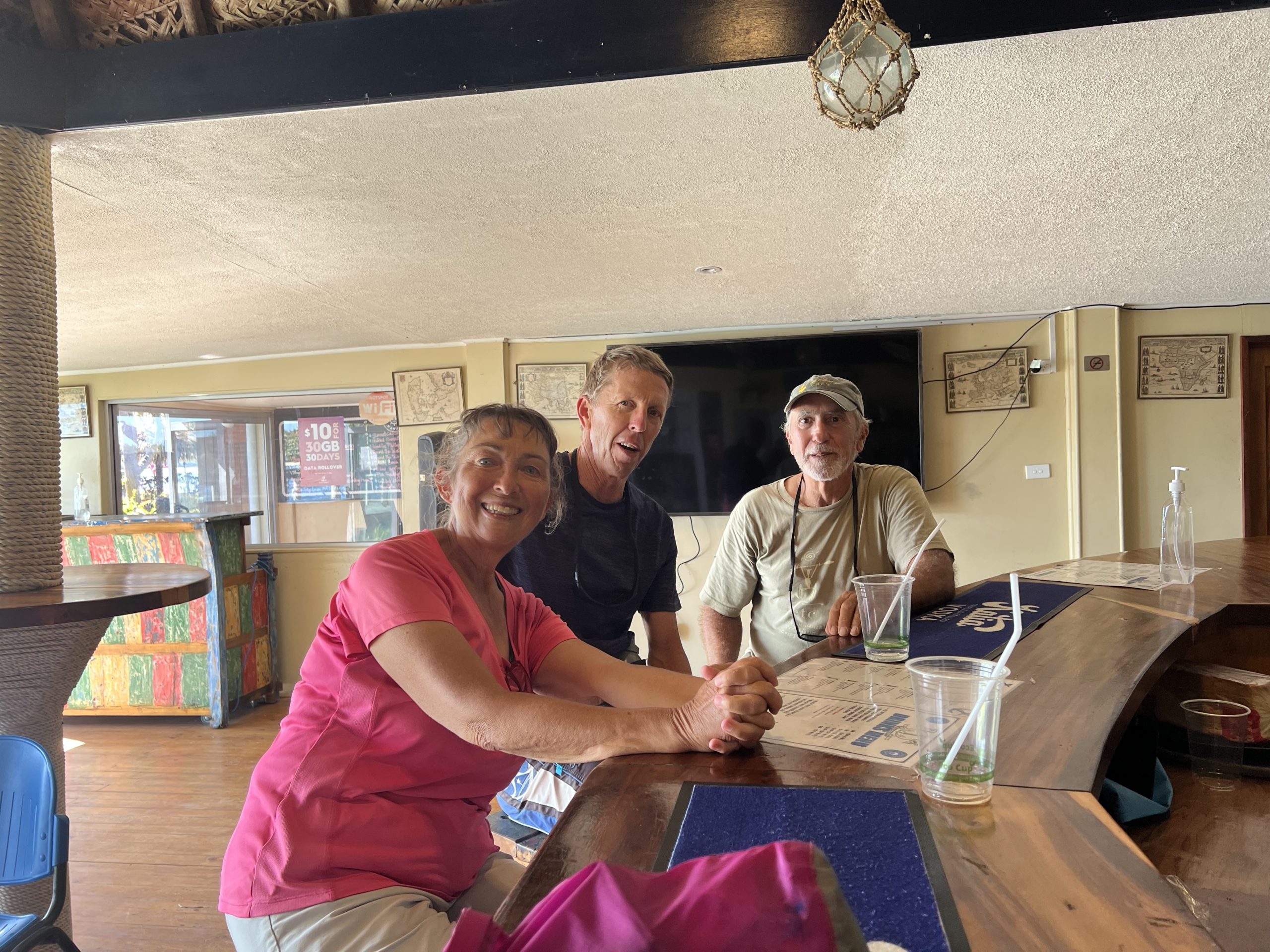
We left Blue Lagoon and had a lovely sail back down to Octopus Resort. It was one of those days sailing that was so beautiful that you wanted to create a movie of it in your mind, to have at ready recall in moments where you’d rather be somewhere else. As if to share in our joy, dolphins joined us on our bow for several minutes. Because we intended to leave first thing the next day, we didn’t deploy the dinghy, so we were confined to the boat for dinner. I didnt have much left to make for dinner, so I found a recipe online for flour tortillas. They came out pretty darn well for my first try. Next I whipped up some salsa from the remaining tomatoes, onions, hot peppers and cilantro I had, and cooked up some packaged spiced meat I dug out of our stores. I even had some beans to add to our impromptu Mexican dinner night!
Yesterday we got back into Vuda Point Marina to take care of some more paperwork and start preparing ourselves and our boat for our kids’ visit in a couple of weeks. After that, we will begin our decommissioning process to store the boat in a cyclone pit until next April. We have booked our tickets home to California at the end of November. We are looking forward to being home again and resuming our routines of dancing, taking daily walks, and spending time with family and friends.

Thanks for this post, I hope to explore the Yasawas next season, so the info is useful.